EDUCATION is an ATMOSPHERE

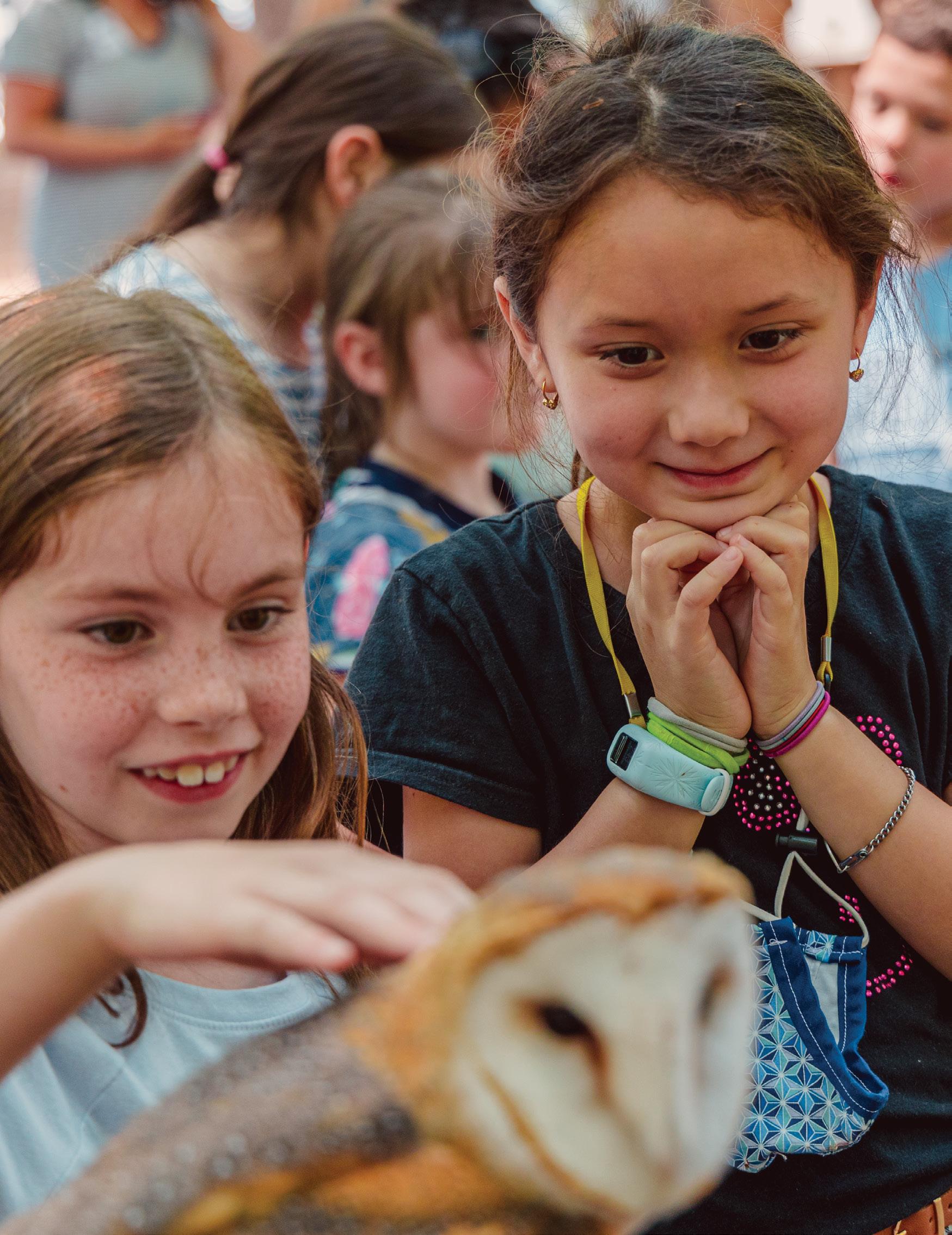
fall 2022 | issue 7
Trinity School of Durham and Chapel Hill
HEAD of SCHOOL
Chip
Denton
ASSOCIATE HEAD of SCHOOL
Jez McIntosh
BOARD of TRUSTEES 2022–2023
Jeff Lloyd, Chair
Harmony Garges, Vice Chair
John Hand, Treasurer
Judith Street, Secretary
Frederick Brooks Jr.
Marsha Ebert
Sandy Kennedy Jim Lamont
Leland Little Ruthie Lyle Aaron McKethan Jay Thomas Didi Wong Chip Denton (ex officio)
MISSION
The mission of Trinity School is to educate students in transitional kindergarten to grade twelve within the framework of Christian faith and conviction—teaching the classical tools of learning; providing a rich yet unhurried education; and communicating truth, goodness, and beauty.
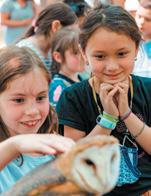
© Trinity School of Durham and Chapel Hill. All rights reserved.
4011 Pickett Road, Durham, NC 27705 919-402-8262 • www.trinityschoolnc.org

EDITOR
Nathan Clendenin | nclendenin@tsdch.org
GRAPHIC DESIGNER
Katie Stokes CONTRIBUTORS
Eveyln Asempah ’29
Judah Cannon ’26
Andrew Chen ’29
Nathan Clendenin Chip Denton
Belle Heinrich ’29 Abigail Jacob ’23 Haley Mazzeo ‘29
COVER PHOTO
Nathan Clendenin
Joan Monnig
David Nolen ’25
Rebecca Nolen
Ben Robbins ’29
Johnny Shoenfelt ’29
Grace Siglin ’29 Carrie Sippy
Ella Solle ’29
If you would prefer to receive The Column electronically, please let us know by emailing us at communications@tsdch.org
Trinity School of Durham and Chapel Hill publishes The Column twice annually, in fall/winter and in spring/summer. Printed in Durham, NC by AdResources, Inc.
Share any article from this issue virtually: www.trinitydch.org/thecolumn
Notice of Nondiscriminatory Policy as to Students. Trinity School of Durham and Chapel Hill admits students of any race, color, national and ethnic origin to all the rights, privileges, programs, and activities generally accorded or made available to students at the school. It does not discriminate on the basis of race, color, ethnicity, national origin, religion, or sex in the administration of its educational and admissions policies, offers of flexible tuition, or execution of athletic or any other school-administered program.
ATMOSPHERE
EDUCATION is an
1 TABLE of CONTENTS From the Head of School Education is an Atmosphere 2 Rich and Unhurried Bird Day: A New Trinity Tradition 4 Prayerful Devotions 8 Learning Never Stops 10 Truth, Goodness, and Beauty Reflections on Trinity’s 2022–2023 School Verse 12 Wonder and Light 14 Imagining Possibilities 16 Yes, And 17 Known and Loved Slaying Medieval Dragons 18 Making Friends Along the Ancient Way 22 Trinity Faculty: Fast Five 26 A Faithful Neighbor 30 Non Nobis Learning Leadership in Athletics 32 Why We Give: The Anne K. Stouffer Endowed Scholarship 34 Alumni News and Notes 36 Kindergarten Harvest Hoedown 41
EDUCATION is an ATMOSPHERE
SPACE TIME BOOKS THINGS
A teacher’s fundamental tools are really very simple: space, time, books, and things. And a good classroom is intentional about them all.
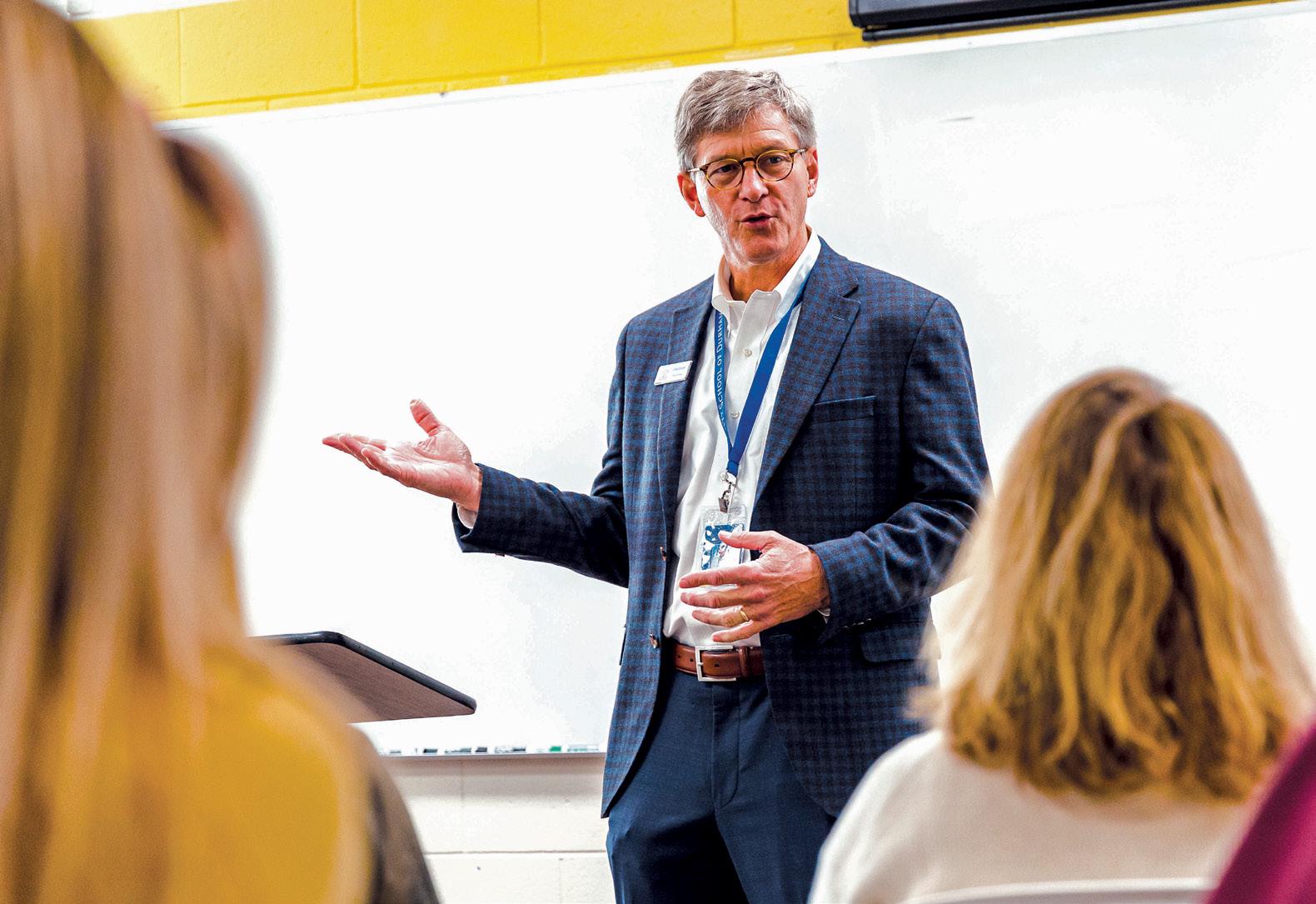
2
Iwould venture that most of us could step into any classroom for thirty seconds and know whether it was a place we would like to stay and learn. We might not be able to articulate why, to name the elements of a space that is well designed for learning, but we would feel it in our souls. This is what Charlotte Mason meant when she said that “education is an atmosphere.”
A classroom is a home for learning. And like a home, it should feel natural and welcoming. One feels free at home—not the sort of freedom that turns one loose, but the sort that settles one into learning. A space that is contrived and artificial for learning is not the sort of space that makes for a rich and unhurried learning experience.
“It is worth while to remember that space is the most precious and also the most pleasing thing in a house or room; and that even a small room becomes spacious if it is not crowded with useless objects” (Mason, Philosophy of Education, 177). Good teachers pay attention to space. They think about order and beauty. They declutter (Mason and Marie Kondo had something in common), and they populate their space with things beautiful and marvelous to behold—
things “lovely in color, form, and texture.” They design the way the furniture and the room are arranged. All of this contributes to our sense of this being a place we would like to settle into for learning.
The atmosphere of learning is shaped not only by the space, but also by the tone of the class—the sounds and the silences, the teacher’s posture and tone of voice, the way she uses time and approaches students. A teacher’s fundamental tools are really very simple: space, time, books, and things. And a good classroom is intentional about them all. One wants to stay and peruse the place, to scan the bookshelves and see what is on the walls.
Trinity’s classrooms are these sorts of spaces. I like to wander the halls and poke my head inside for just a short time, to absorb quickly the culture of the room. Often I think, “I wish parents could feel and experience that.”
In this issue of The Column, you will be able to step into some of these classrooms and see things that shape our learning culture: from the first graders’ bird studies, to the arts, to our Lower School writing. You will hear from one of our Upper School students about the lifelong learning that this atmosphere inspires. And in David Nolen’s tribute to our neighbors, the late Wade Penny and his wife, Carolyn, you will learn about the wonderful land at the end of Pickett Road that has become our great outdoor classroom.
I recall that the disciples on the road to Emmaus (Luke 24) did not grasp who Jesus was until they arrived at a home, went inside, and sat down at the table with him. Then their eyes were opened to see who it was that they had been walking with. It was an atmosphere ripe for learning. May God multiply that story over and over at Trinity School.
 Chip Denton, Head of School
Chip Denton, Head of School

3
Studying birds has long been a part of the rich and unhurried first grade curriculum at Trinity. The bird unit leads our younger students through a memorable and formative journey of learning. Even some of our earliest Trinity graduates can tell you all about the bird they studied!
Megan Wright, who has been a first grade teacher at Trinity for 20 years, says she didn’t start out being all that knowledgeable about birds. But after teaching the unit a few years in a row, her appreciation grew. “Birds are universal in their appeal to students,” she shared. “I see how they display God’s magnificent handiwork.” As Mrs. Wright spent time nurturing her new interest, she gained more inspiration to pour into the lessons for students.
When support from the Trinity Fund was made avail able for faculty professional development, Megan began
First grade parents, grandparents, and friends gathered for Bird Day on May 18, 2022. Students first shared their own research, which included a watercolor of their bird and a model of its nest. Next, they gathered outside to see a live bird demonstration, including petting a live owl.
dreaming about the possibilities. She had known about the Cornell Lab of Ornithology in Ithaca, New York, a widely respected resource for bird educators and pro ponent of citizen science. She wasn’t sure she’d get approval for this trip to Cornell—it seemed too good to be true. But her nature notebook, full of inspired lessons and creative ideas to teach her students, is proof that dreams do come true.
Stepping foot onto the Ornithology Lab grounds in 2018, Mrs. Wright found herself back in the student’s seat. This time around, her classroom was God’s, complete with the welcoming song and chatter of a wide array of winged messengers. Joined by a collection of other teachers, park rangers, and other lifelong learners from around the country, Wright embarked on a week-long Educator Retreat oriented around inquiry-based learning. The participants spent lots of time outdoors observing birds, asking questions, and going deeper into bird
4
RICH and UNHURRIED | Trinity School
special days LOWER SCHOOL
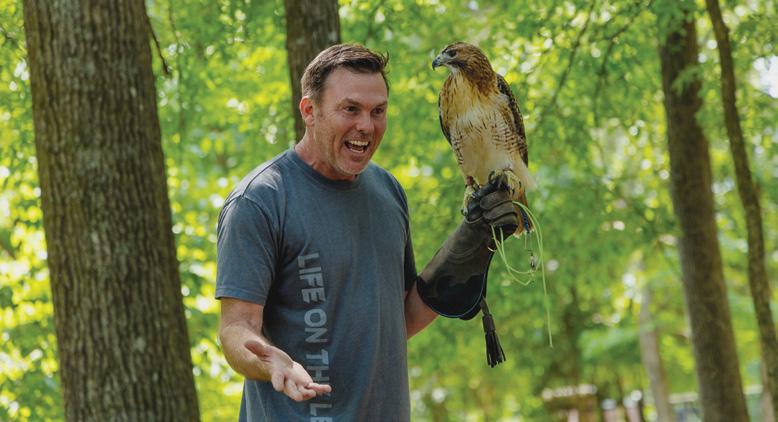



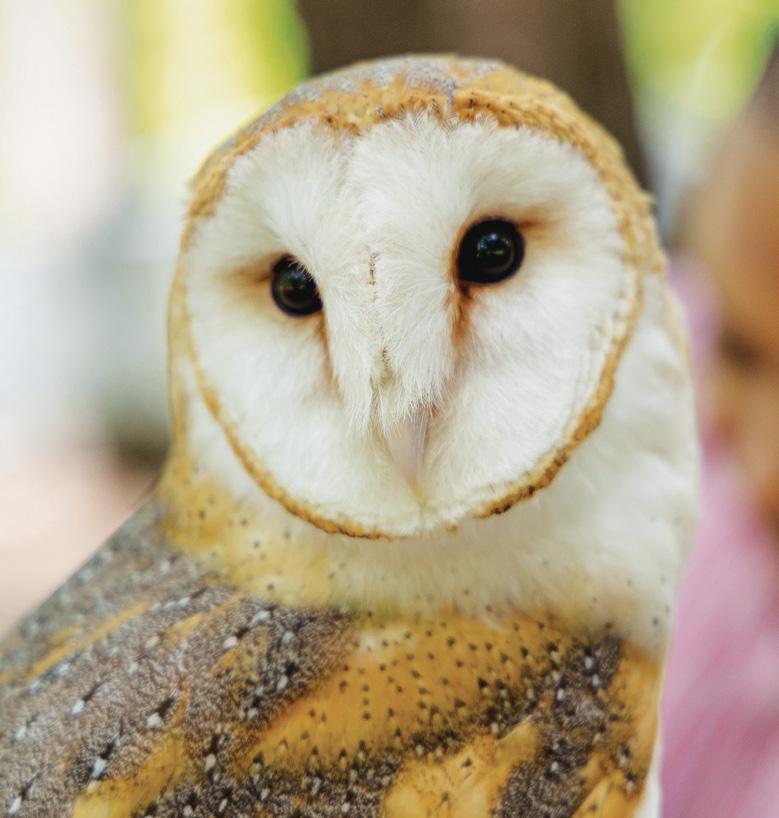
In each Lower School grade, Trinity students get to study a topic or person in depth, in preparation for a special event in which they share what they've learned with their peers and parents. Through their presentations, the students gain a deeper understand ing of their subject that goes way beyond learning from a textbook or a lecture. Here are just some of the special days in the Lower School.
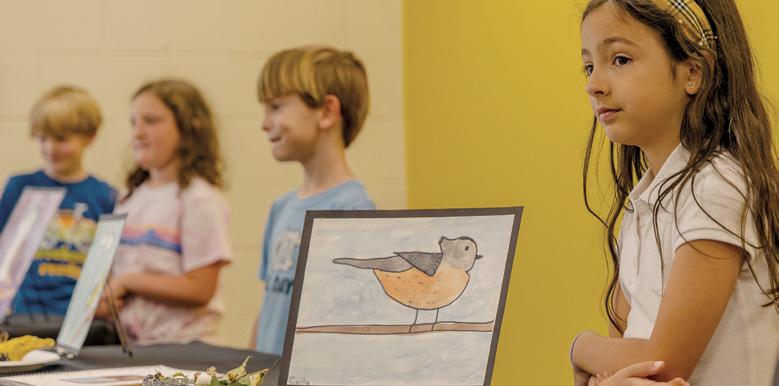
5
Christmas Showcase
Bird Day (1st) Colonial Trade Day (2nd) Country Day (3rd) Biography Day (4th) Greco-Roman Day (5th) Medieval Day (6th)
TK Circus
(K)
anatomy and adaptations, bird songs, and markings. They spent time working in their nature journal, complete with sketches, observations, and questions to explore more deeply.
As part of her week of study, Wright conducted citizen science research. The Cornell Lab of Ornithology describes citizen science as “people across the continent help[ing] scientists by collecting data about their local birds and sending the information to scientists who study bird popu lations and conservation.” The Lab has developed an array of tools for citizen scientists of all ages to contribute their findings. From bird feed watching to nest observations and backyard bird counting, there are ways for everyone to participate in meaningful scientific projects.
Mrs. Wright explored the research question “How does an owl decoy affect the number of times birds visit the feeders at the feeder station?” Her results confirmed the hypothesis that an owl decoy diminishes the number of bird visits to the bird feeders: birds observed in a 10-min ute period went from more than 50 without the owl decoy down to as few as 11 when a decoy was present.
Returning from the workshop, Wright felt renewed and well prepared to inspire her next class of students to be come bird lovers themselves. “It’s always so interesting to see how the students’ bird study affects how they play at recess. They start building little nests with sticks and pine needles, and they’re paying attention to the birds they see out in the woods,” she noted. Watching their
interest grow with her own, Megan saw an opportunity to pull together the different pieces of the bird unit into a new Trinity tradition, Bird Day.

Students in both first grade classes, along with their parents, came together last spring in a new way to showcase their bird projects and experience a live bird demonstration. Inside the Lower School, parents mingled among watercolor portraits of birds and carefully crafted nest replicas, asking questions of each student. Eagerly, the students shared the knowledge and enthusiasm they had gained while preparing their first-ever reports in their Trinity educational arc. Outside, the two classes took turns learning with Chip Gentry of Hawk Manor Falconry in Lillington, NC. Many got to see the birds they’d researched live and up close, from tiny owls to large vultures. The oohs and ahhs could be heard all around.
Trinity parent Liz Goodmon, a Bird Day participant, shared, “To see the comprehensive unit come together in the form of a fun, interactive learning activity for our families truly embodied Trinity’s mission of an unhur ried approach. Bird Day will definitely go down in the books as a family favorite!” Mrs. Wright concurs: “Bird Day is a chance to see all that they have learned come together and take flight.” The fruits of the long arc of Trinity’s first grade bird studies were clearly seen in our students’ excited faces, and their growing love of learn ing will create a rich foundation for the researching and presenting that awaits them in the years to come.
6 RICH and UNHURRIED | Trinity School
TRINITY FUND
Generous investments in the Trinity Fund, year after year, support our skilled and devoted teachers as they seek to sharpen their craft and excel still more. Like the professional development that Megan Wright experienced at Cornell and many other opportunities our faculty have enjoyed, your investment will help Trinity fulfill its mission to provide a rich, unhurried education for all of our students.
You can make a donation to the Trinity Fund at www.trinitygives.org.

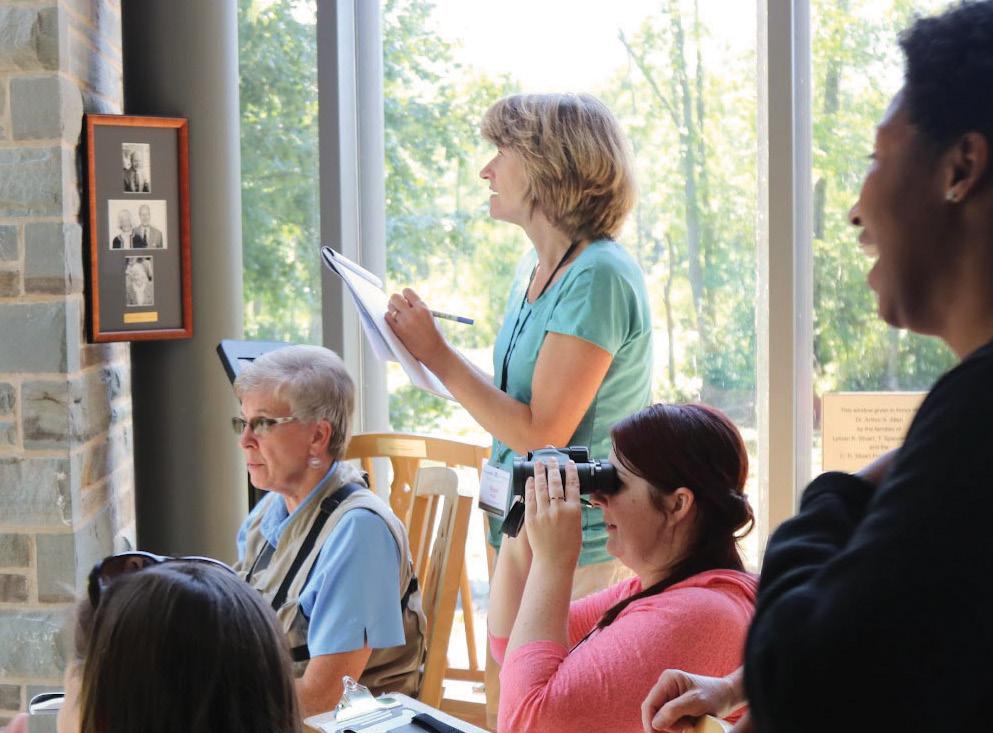

Budding Birder
The Cornell Ornithology Lab has developed a worldwide platform for collecting bird data called eBird. Bird lovers of all ages and locations can contribute to avian observations through eBird and the popular MerlinID app, which ties into the eBird data. Search for the app to begin your own citizen scientist journey!
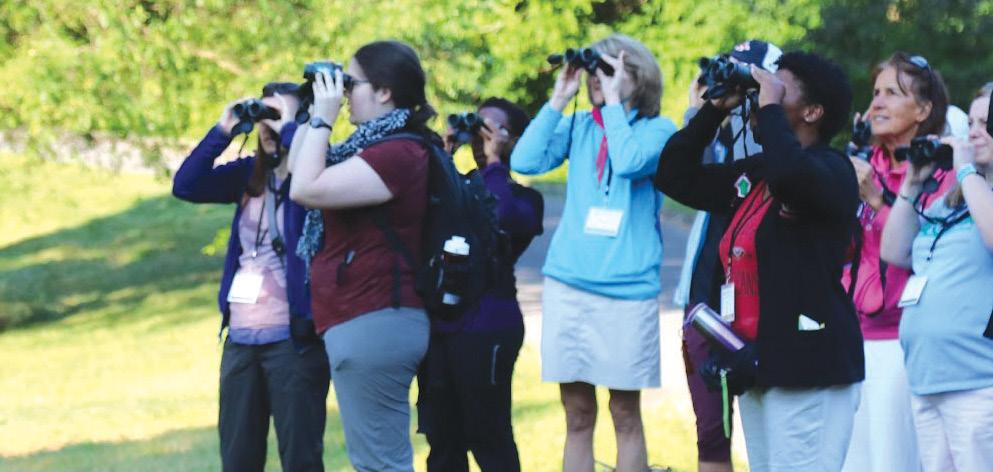
Or donate using this QR code.

7
NATHAN CLENDENIN serves in the Advancement Office as Trinity’s Assistant Director of Advancement for Marketing and Communications. A husband, father of four children, and Trinity parent, he loves a great podcast and can be found listening while training for the annual Blue Ridge Relay.
Mrs. Wright’s vision for Bird Day was birthed at an Educator Retreat sponsored by the Cornell Ornithology Lab in 2018.
Prayerful Devotions
The Lower School students, teachers, and staff have been thoughtfully considering the subject of prayer during this year’s Lower School Fellowship gatherings, Thursday intercom devotions, and morning devotions in the hall before school starts. In Lower School Fellowship, they have talked about what prayer is and what attitude we should reflect during prayer—one of love, perseverance, and gratefulness, as it says in Philippians 4:6.

We know that people who loved God—like King Solomon (1 Kings 3:9), Moses (Exodus 33:18), and Mary (Luke 1:38)—prayed, and the scripture calls us to pray, too (Jeremiah 29:12, Colossians 4:2). We all practice being people of God when we pray with our families, friends, teachers, and classmates. It is a privilege and gift for the Lower School community to pray together and so glorify El Elyon, God Most High.

State Champs! State Champs!
Trinity wins the NCISAA 2A State Championship for Girls Tennis
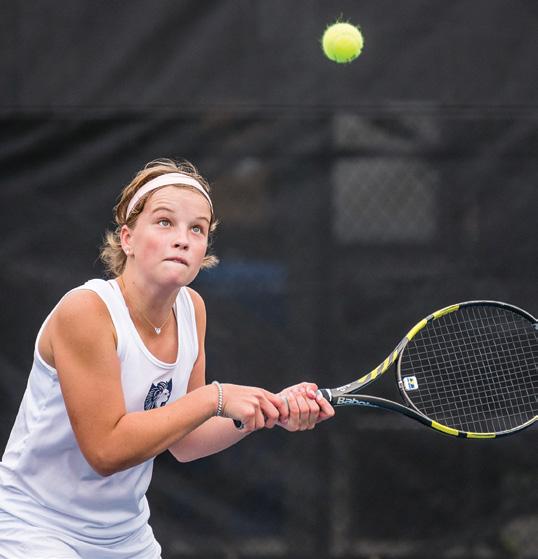
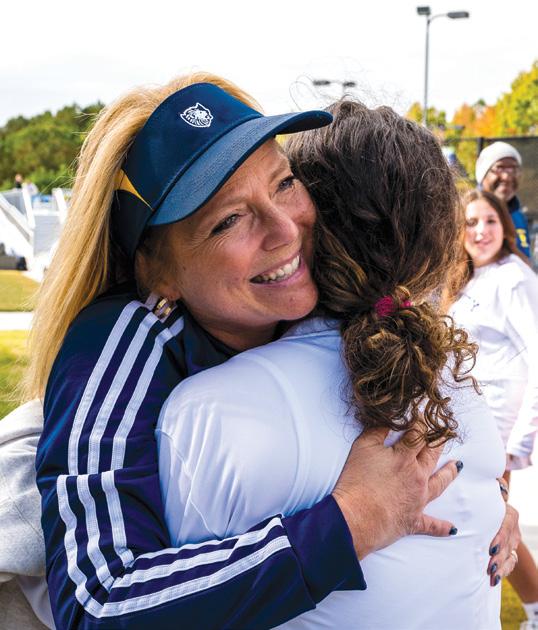
On Saturday, October 29, 2022, the Varsity Girls Tennis team defeated Gaston Day School to secure the NCISAA 2A State Championship. Congratulations to the athletes, who worked hard all season, and to the coaches who guided the team. Thank you to the families that came out to all the matches and made this accomplishment possible! All glory to God for his great gifts, and may he bless all those who competed this year in Varsity Tennis.


9
Photography by Evan Pike
Learning Never Stops
By JUDAH CANNON ’26
The Hank & Billye Suber Aaron Young Schol ars Summer Research Institute is a threeweek program for high school students that focuses on strengthening writing, research, and presentation skills. A primary goal of the program is student ownership of their learning experience, and exposure to the process and tools needed to engage in critical inquiry.
The program is sponsored by the Samuel DuBois Cook Center on Social Equity at Duke University, under the leadership of Professor William A. Darity Jr. and Dr. Gwendolyn Wright. My mission this summer was to engage in the study of the causes and consequences of inequality related to my research question, and to explore curriculum related to the economic, social, and political dimensions of inequality. My research, entitled “Black Baseball Players Matter,” focused on this question: What barriers work against African Americans’ progress in their professional baseball journeys, transitioning from high school to college?
Judah Cannon ’26 presents his findings to fellow students, parents, and researchers in a program at the Washington Duke Inn.


10
and UNHURRIED
Trinity School
RICH
|
My
My research confirmed that the lack of representation, financial accessibility, and limited funding for collegiate opportunities contribute to underrepresentation of Blacks in Major League Baseball. The data showed that despite the success of Black heroes like Jackie Robinson, Hank Aaron, Willie Mays, and Ken Griffey Jr., who have paved the way for today’s Black youth to be able to play professional baseball at the highest level, the number of Black athletes playing the sport has declined steadily over the last 20 years. Young Black athletes have found it easier, in most cases, to pursue other sports, such as basketball, football, and track, where there are significantly higher representations of Black players and coaches and funding.
In addition to learning more about my research topic, I had a chance to meet and work with students from other

high schools in and out of state, mostly public. I also developed my writing skills, using the MLA style to create my research paper. In July I shared my results in my first Senior Capstone presentation to an audience of students, parents, and researchers at the Washington Duke Inn. I’m grateful to my parents for encouraging me to apply to participate in the program. It was a lot of work during the summer, but I learned a lot and plan to return next year.
View Judah’s presentation at http://trinitydch.org/ tc7learning
JUDAH CANNON came to Trinity in seventh grade. He appreciates the opportunities that Trinity School provides for students to try different types of sports in a supportive environment. A baseball player since the age of four, he has come to value baseball both as a sport and because it has given him an avenue to spend time with his parents, especially his father, who served as a head coach and board member for the South Durham Little League. Judah also enjoys basketball and has played with the Durham Lakers for several years. In his free time, Judah participates in competitive Lego builds. He likes drawing and was glad to have the chance to take an art class last year
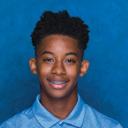

11
research confirmed that the lack of representation, financial accessibility, and limited funding for collegiate opportunities contribute to underrepresentation of Blacks in Major League Baseball.
Reflections on Trinity’s
12 TRUTH, GOODNESS, and BEAUTY | Trinity School
2022–2023 SCHOOL VERSE
I JOHN 3:18 TRUTH, GOODNESS, and BEAUTY | Trinity School
“Dear children, let us not love with words or speech but with actions and in truth.”
“We’re called to love each other and we’re called to act on it, and I think the verse is a really good reminder that we can’t ignore that. We can’t ignore that as part of our faith.”
“If there was a community where everyone lived by this verse, I think there’d be a lot less arguments and fighting. People would be able to express their opinions more freely and feel comfortable being who they are.”
“When my parents tell me that they love me and they hope I do well at my soccer game, it means a lot to me. But when I look over on the sideline and I can actually see them there cheering me on, it gives me motivation and it gives me happiness that I’m actually playing this sport. It means more.”
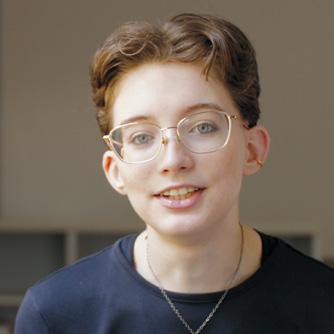
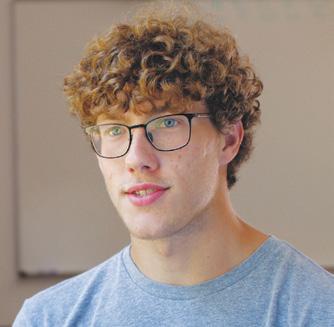
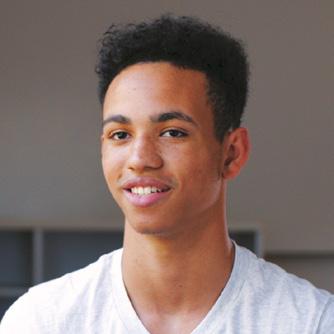
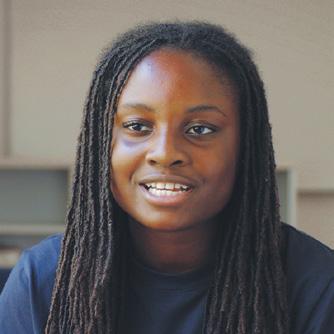
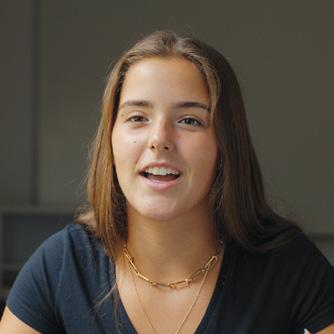
“Jesus dying on the cross was the biggest thing to prove to us that he loves us. We are God’s image, so to show how he loved us, we have to do that, too.”
“Truth means always being honest with your peers, and just being your full self and not trying to be anything that you’re not.”
13
SAVANNAH HICKS
ELI MCMURRAY
ANNA DARR
ABIGAIL JACOB
THEODORE LUCAS
Wonder Light &
in Lower School Arts
 By Rebecca Nolen
By Rebecca Nolen
Old Tom Bombadil is my favorite of all J. R. R. Tolkien’s characters in The Fellowship of the Ring. After guiding an exhausted Frodo and his friends out of the frightening Old Forest, Tom Bombadil welcomes the Hobbits into his home, a place of wonder and light. In addition to providing the Hobbits safe rooms for resting, Tom restores their courage with joyful songs, poetic conversations, nourishing meals,
and the tended beauty of their surroundings. Through both hospitality and the arts, the Hobbits are prepared to receive the wise guidance Tom gives for their journey.
While Ashley Weinard and I don’t leap and sing like Tom Bombadil or take journeys with ponies like Hobbits, we do have a vision for the Lower School Art Studio that resonates with Tolkien’s imagination.
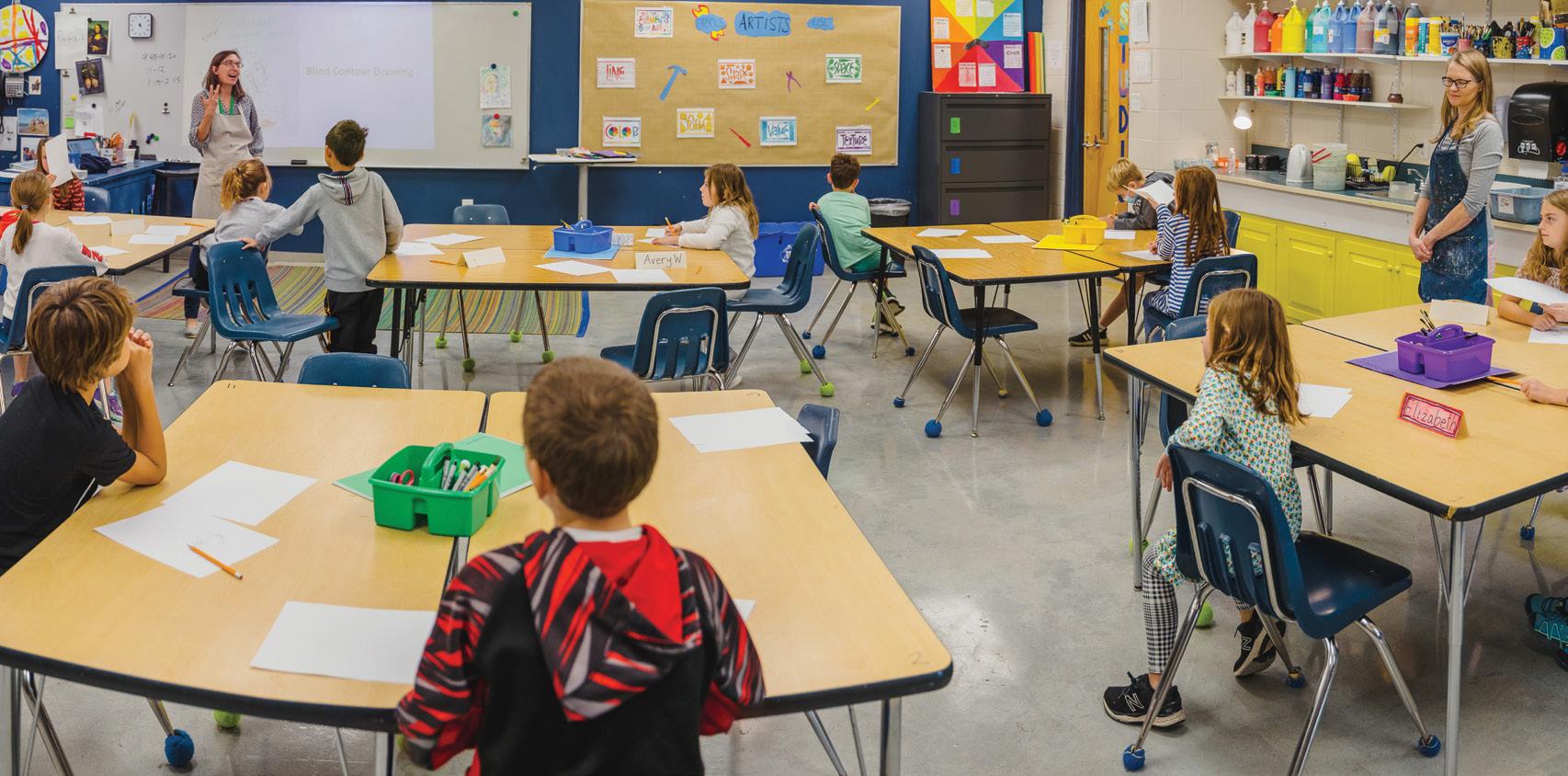
14
TRUTH, GOODNESS, and BEAUTY | Trinity School
We seek to design a classroom that feels like a home for learning—a welcoming, lovely place for our students to experience the visual arts and to be led, like Frodo, toward wisdom and courage.
When Lower School students visit the Art Studio, they are eager to experience the tactile aspects of the visual arts curriculum. Whether cutting paper for collage or sculpture, manipulating clay for a vessel, color mixing with paint, or learning to shade with pencil, our artists are engaging with good materials in ways that grow their mental and physical dexterity.
In our room, children encounter beauty and learn to speak the language of artists by naming elements that make a created thing beautiful—line, shape, color, texture, form, space, and value. Having words to explain visual art brings a sense of order to the visible world. In response, students skillfully apply these elements to their own artworks to create something unique. The Art Studio is also a place where students are invited to wonder. Before the students enter, they are greeted with a question: What is your favorite kind of line? What is the most beautiful place you have ever seen? How does art help us
understand other cultures? What does it mean to persist in a challenging task? Students practice listening to each other answer these questions.

The studio activities help students grow in wisdom: courage to try something hard, kindness in words spoken about another’s creation, consideration as they share space and supplies, and compromise during collaborative projects.
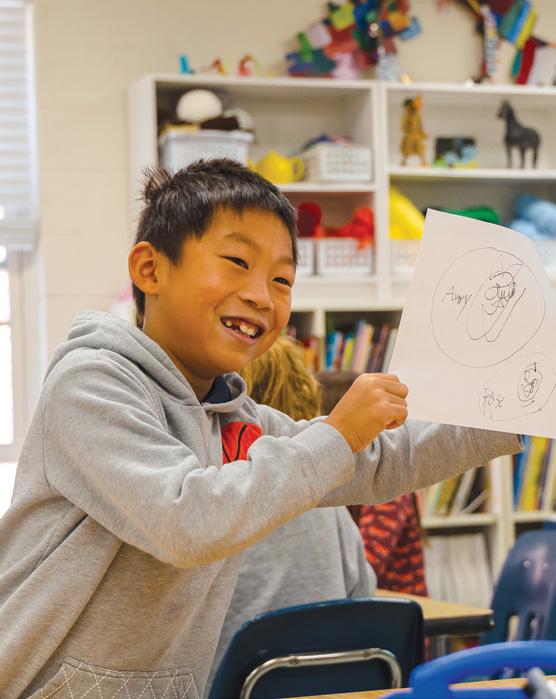
We pray that the Lord will fill the Art Studio—and all the rooms of our students’ hearts—with that which is good and true, wonderful and beautiful. As our children grow to
our room, children
beauty and learn
speak the language of artists.
By wisdom a house is built, and through understanding it is established; through knowledge its rooms are filled with rare and beautiful treasures.

Proverbs 24:3-4
REBECCA NOLEN has served as a teaching assistant in Trinity’s Lower School Visual Arts program since 2016. She loves supporting students in TK through sixth grade as they explore many different art media and ideas. In her free time, she enjoys hiking in local forests with her family.
15
In
encounter
to
Imagining Possibilities
in Upper School Arts
By Carrie Sippy
The arts provide a space for students to imagine the possibil ity of what might be, instead of just seeing what is, and create in collaboration with others. In Upper School Jazz Ensemble, instru mentalists look at the chords and structure of a song and learn how to improvise solos that work in tandem with other performers. Vocalists discover together the way choreography helps tell the story of a song to the audience. Students and faculty explore together what it means to build a culture and community of learning that is both academic and artistic.
When Alina Ruffin (’25) gifted her friend an origami butterfly, her friend mused how cool it would be to use origami in a Studio I project, and Alina’s vision of a dress covered in butterflies began to take shape. While this plan did not strictly fit the guidelines of the assignment, she ran her idea by Ms. Rector, her Studio I teacher, who loved it and en couraged Alina’s creativity. Alina said, “Through Middle and Upper

School with the projects we’re doing, it has inspired me to be more creative and look at art with a different perspective. It shifted my thoughts from, ‘What does the teacher want me to do?’ to ‘Is there anything outside of the guidelines I can incorporate into this to produce a more creative piece?’”
As she challenged herself to think more creatively, Alina folded 500 butterflies, created an overskirt and underskirt, and patterned a bodice based on the design of tutus (she is also a talented dancer!), sewed the dress, and attached the butterflies. Along the way, friends helped Alina carefully cut holes into the butterflies so they could be attached to the skirt. The end result was a stunning creation that truly reflected the community present in Alina’s Studio I experience.
Alina Ruffin ’25 models her butterfly gown, which she created for her Studio I art class.

16
TRUTH, GOODNESS, and BEAUTY | Trinity School
If you stop by the theatre room any Monday, Wednesday, or Friday around noon, there’s no telling what you might see. Perhaps you’ll hear a story of a student who went on a vacation to Pluto or observe a party featuring Lebron James, Cinderella, and R2D2 as guests. All of these wacky and wild moments come from the improv rotation in the seventh grade Arts Exploration. The truth is, I can never predict what the Middle School students will come up with, and that’s where the learning and the fun happens. Though they’ll proba bly never join an improv troupe, the students are learning valuable skills that extend beyond the classroom and the stage.
My favorite part of improv is that it is truly a group undertaking, and the
Yes, And
in Middle School Arts
By Carrie Sippy
ensemble “wins” or “loses” together. The actors collaborate to build some thing new, and this requires mutual respect, risk-taking, and a willingness to embrace failure. Not every idea will work, not every scene will go the way you envisioned it, but as you work together, it is the communal efforts of each person that produce the most hilarious and satisfying moments.
The art of improv takes a great deal of courage. Actors put themselves onstage for others to see, respond to, and critique, and that is a very vulner able process. Middle School is often a time when students are concerned about what other people think or how they are perceived, so asking students to step outside of their comfort zone in this way is a huge request. Howev er, improv gives students the chance

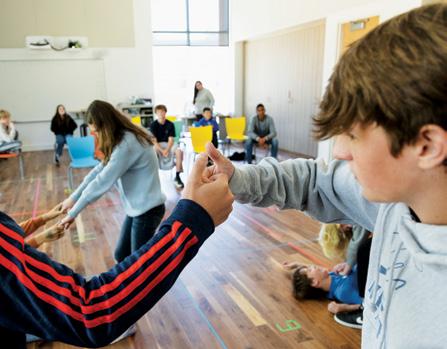
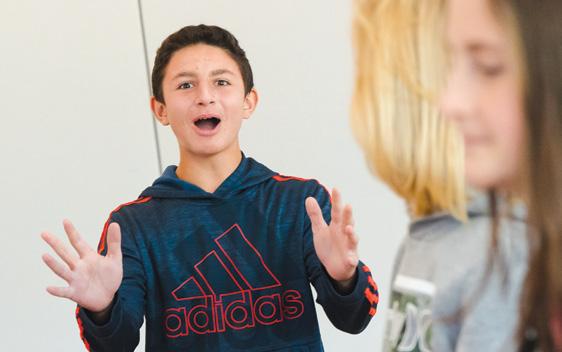
to explore with the support of their peers what it means to “be the color blue” or hold a press conference as the mayor of a town that’s been flooded with soda. While the subjects may often be silly, there is much to be learned in among the bursts of laughter and funny character voic es—namely that what the students can accomplish together is greater than what they could individually.

RULES OF IMPROV:
“Yes, and” Take big risks Embrace failure Respect one another
CARRIE SIPPY,
and
teacher, is in her eighth year at Trinity. While she is normally behind the scenes of Trinity’s productions, she loves the opportunity to stretch her performing muscles and has been seen locally in shows such as The Lightning Thief, Into the Woods, and Mary Poppins. When not in rehearsals, she can be found cross-stitching, baking, or hosting game nights.
17
our Middle
Upper School Theatre
Slaying Medieval Dragons
 By Joan Monnig and a selection of sixth grade students
KNOWN and LOVED | Trinity School
By Joan Monnig and a selection of sixth grade students
KNOWN and LOVED | Trinity School
Insixth grade, students begin the study of the medieval period by reading the Anglo-Saxon legend, Beowulf. The ancient work is considered a foundational piece of English medieval literature.
In three parts, the epic tells of the hero, Beowulf, who slays the monster Grendel, then slays the monster’s mother, the Sea-Hag. Later in his life, Beowulf also slays the fire dragon or fire-drake, but during this combat, Beowulf is mortally wounded.
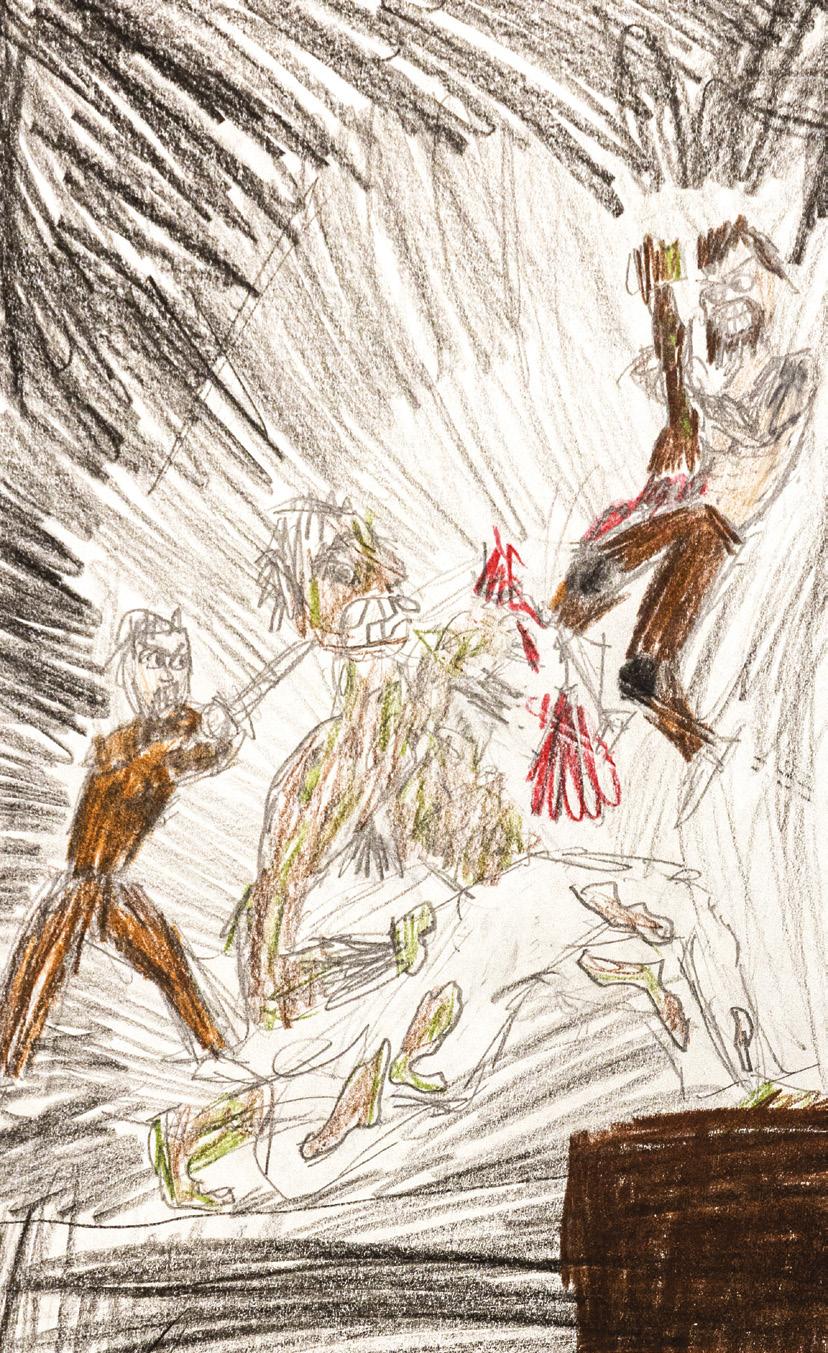
After reading the legend for themselves, students were asked to respond with an individual project from a range of choices. They could draw a scene or turn a portion of the legend into a comic strip. They could orally retell a portion of the story, write a character speech and perform it, or rewrite a scene from another character’s point of view. In their project, students supported their stances with textual evidence from other retellings by authors Mary Pope Osborne, Ian Serraillier, and Rosemary Sutcliff.
Step into the story through the students’ depictions and retellings of this classic legend, shared here.
Beowulf Slays the Monster Grendel 1
19
(right) Beowulf Rips Off the Arm of Grendel, by Ben Robbins (left page) Beowulf Slays the Fire-Dragon, by Andrew Chen
Writing from the point of view of Grendel’s mother, Belle Heinrich (BH) and Ella Solle (ES) explore the themes of grief and revenge, which were deeply embedded in the medieval culture that birthed the Beowulf epic. We enter the scene as the monster Grendel is discovered dead by his mother.
After some time passes, Beowulf is met with a new challenge. A sleeping dragon has awakened to find some treasure missing, and it suspects a human is the culprit.
Grace Siglin explores this part of the story from the dragon’s point of view:
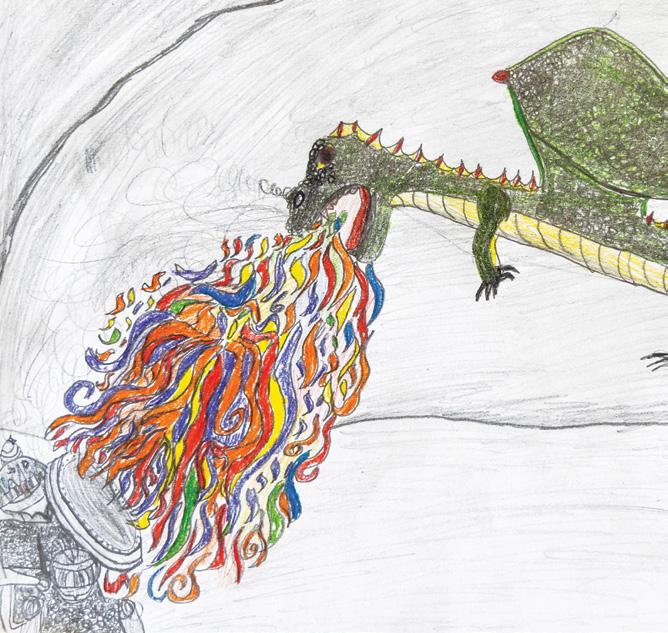
After the fire dragon had burnt all of the villages and towns, he flew back to his cave to rest. When he ar rived there were warriors with iron shields and jeweled swords. As he spit out fire, all of the cowardly warriors ran into the trees to hide. Only two warriors were left, ready to fight under a cave carved long ago by giants. “What a puny king,” thought the fire-drake….The drag on bit into the king’s neck with his poisoned teeth. Sud denly, the fire-drake heard a loud yell and saw the other thane charging. All of the dragon’s wrath was turned on the soldier. Even as he tried to burn the skilled warrior,
Beowulf Slays Grendel's Mother
BH: Deep in the black waters of the swamp I held my son, blood dripping down my hands. I felt a rush of grief and anger…I followed the blood trail to the Heorot. With each step, I said, “Grief, Revenge. Grief, Revenge.”
ES: Beowulf attempted to pierce her skin in vain. His mighty sword failed him. Greneta pinned him down and wept. This monstrous thane murdered her beloved son, whose life she valued more than her own. She raised her hand to kill Beowulf, but his wits and fast thinking saved him. He grabbed a sword from the wall, an ancient sword forged by giants. Then, he prepared a mighty blow. The blade was cold, hard, and cruel as it sliced through her neck.
2 3
Beowulf Slays the Fire Dragon
he felt a deadly pain in his stomach. He realized one of the jeweled swords was thrust deeply into him, home to the hilt. As he took his last breath he was wreathed in his own smoky breath that curled up and then quickly cooled.
Beowulf houses Wiglaf under his iron shield while fighting the dragon, by Johnny Shoenfelt
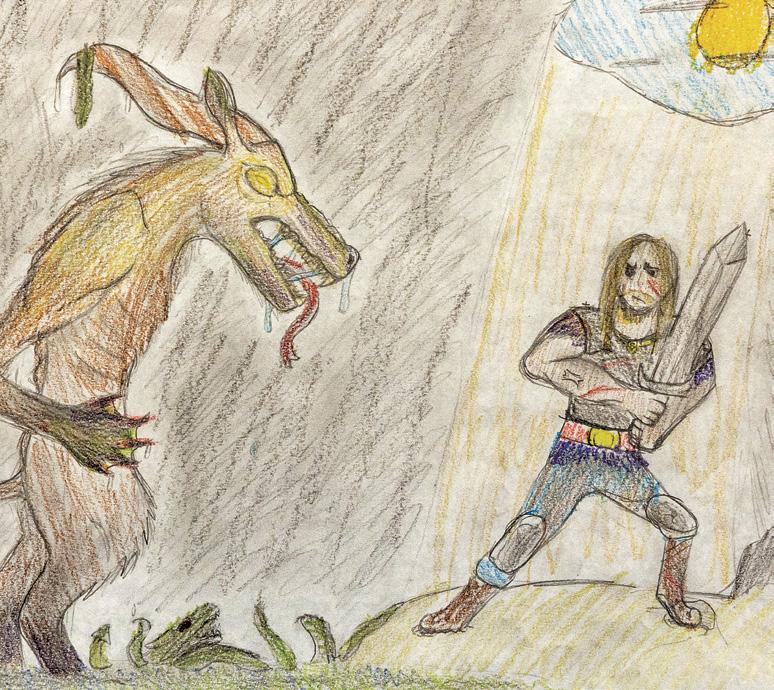
20 KNOWN and LOVED | Trinity School
Beowulf Slays Grendel’s Mother, by Haley Mazzeo
JOAN MONNIG is in her third year of teaching at Trinity. She enjoys leading the unique energy of sixth grade students and supporting their individual development as communicators. When not reading her favorite author, Shakespeare, or cooking nutritious meals, she can be found in the mountains of North Carolina camping, hiking, and whitewater kayaking with her friends and adult children.
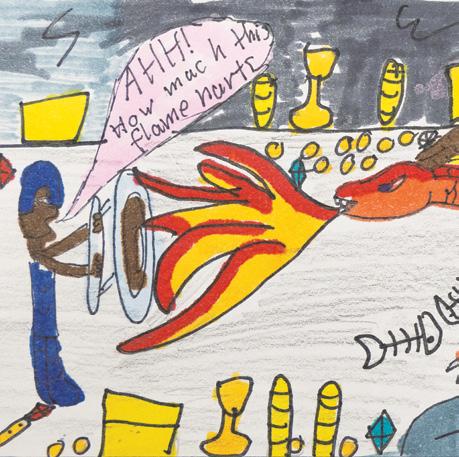








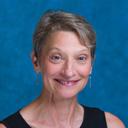
21
Beowulf Slays the Fire Dragon, by Evelyn Asempah
Making Friends Along the Ancient Way
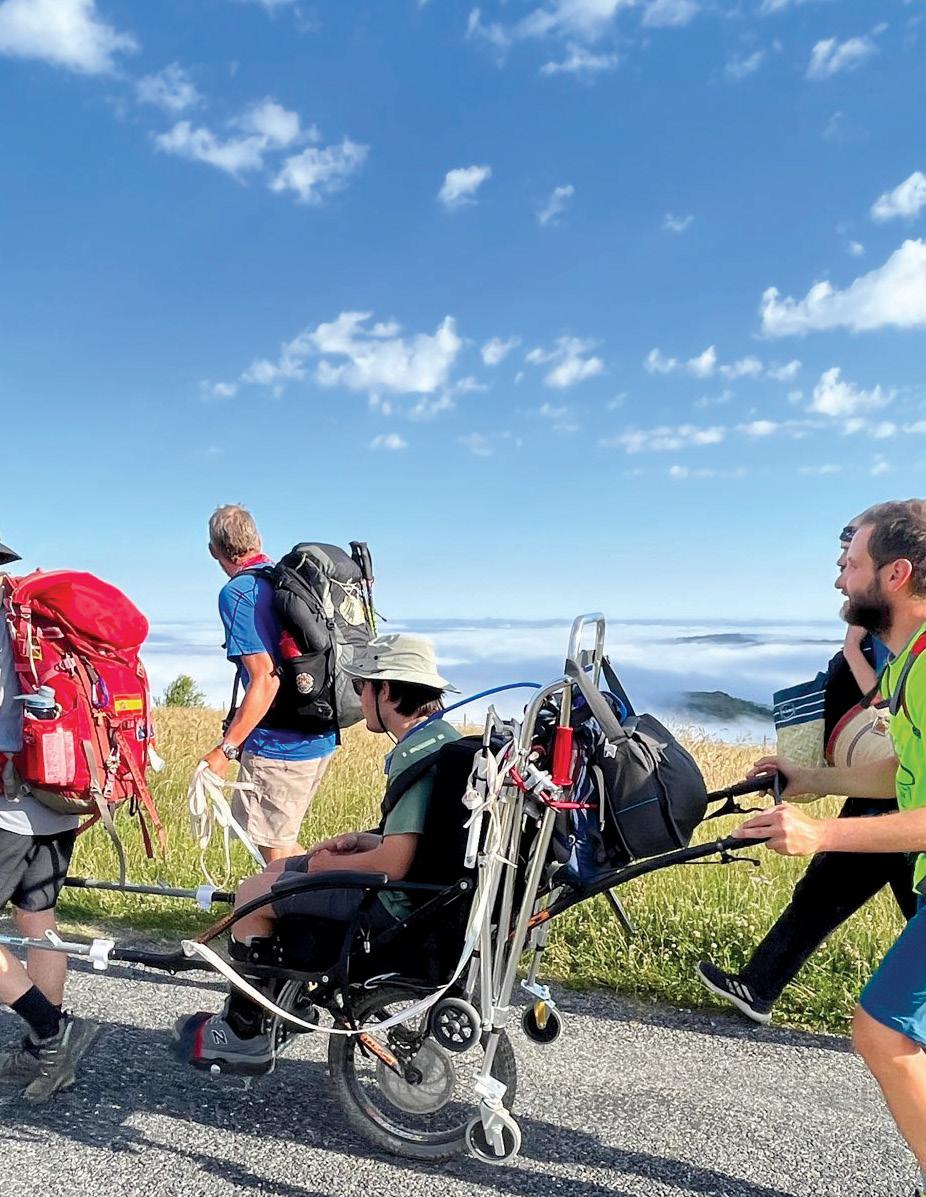 by NATHAN CLENDENIN
KNOWN and LOVED | Trinity School
by NATHAN CLENDENIN
KNOWN and LOVED | Trinity School
Trinity alumnus Gabriel Tempest ’21 began a special journey at the age of 14. Now 19, Gabriel is an undergraduate at East Car olina University, and as of this summer he can put completing the Camino de Santiago among his list of achievements. This pilgrimage, also referred to as the Ancient Way, is a walk of introspection, a form of physical fasting as one pushes the body, mind, and spirit to its limits. For many who make the journey, including Tempest, who has a mild form of cerebral palsy, the process is communal. Gabriel completed the trek with the help of his former Trinity teacher Kym Gardner and a support team of many more friends and champions.
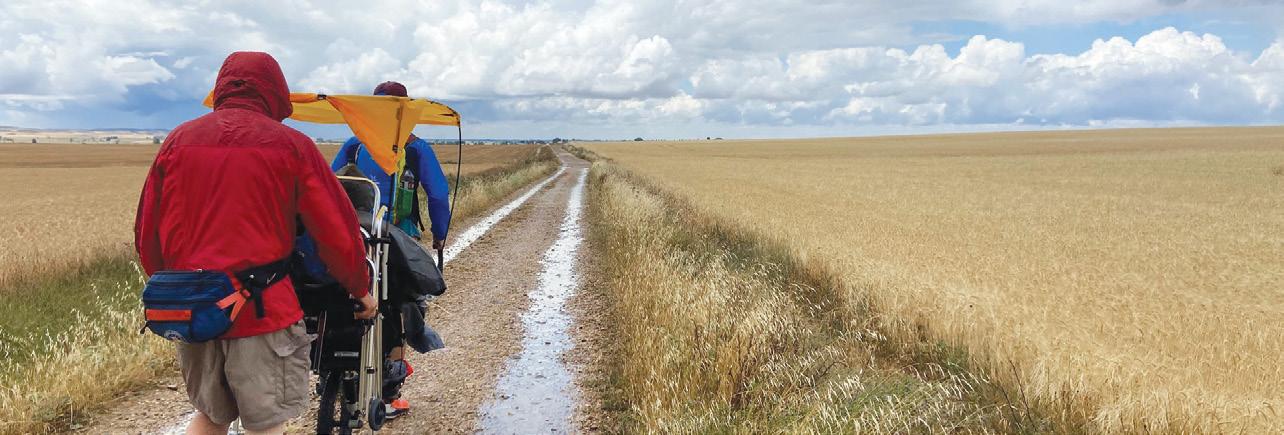
School Engineering Club, along with Upper School ers and staff members, came together to design the canopy for Tempest’s carriage. The chair Tempest used is designed specifically to carry someone over terrain, through inclement weather, and to provide a safe, secure seat. After months of engineering and modifi cations by the students, a classmate used Trinity’s 3-D printers to produce a canopy so Tempest could have shade on the journey.
Gardner, a veteran Trinity Middle School teacher who now works in the Facilities Department, taught Gabriel in the eighth grade, and the two formed a friendship that has gone from the classroom in Durham, North Carolina, all the way to Spain. Upon hearing about Gardner’s previous Camino trips at a Latin summer camp at Trinity, Tempest was inspired and determined to make his own pilgrimage.
Before the first miles could be logged, it took a village to envision how Tempest would manage the 500-mile trek. Under Gardner’s direction, Trinity’s Middle
In the summer of 2018, a team of 14 pilgrims joined Tempest as he traveled from St. Jean Pied de Port, France, over the Pyrenees to Logroño, Spain—a little over 100 miles. The following summer, Tempest and his team of volunteers traveled another 100 miles, from Logroño to Castrojeriz. Team members have included Kym Gardner and his wife, Susan; current and past Trinity faculty, including Daryl Steel; family members; and some of Gabriel’s former helpers. The team origi nally planned to complete the entire 500-mile journey walking 100 miles each summer, but Covid-19 delayed their plans for two years. So on this last trip, Gabriel and his group trekked nearly 300 miles to complete the pilgrimage.
A Merry Band of Travelers
“Gabriel naturally draws people in,” remarks Gardner. “He has never met a stranger, and all throughout this journey, people have been drawn to him and the expe rience of the team on the trail.” Those with disabilities can often feel isolated. People may not be quite sure how to interact with someone who speaks slowly or is
23
He has never met a stranger, and all throughout this journey, people have been drawn to him and the experience of the team on the trail.
using an assisted walking device. But what could have been a bar rier became a magnet on the Camino. Gabriel’s crew grew from one summer to the next as more people learned about the group.
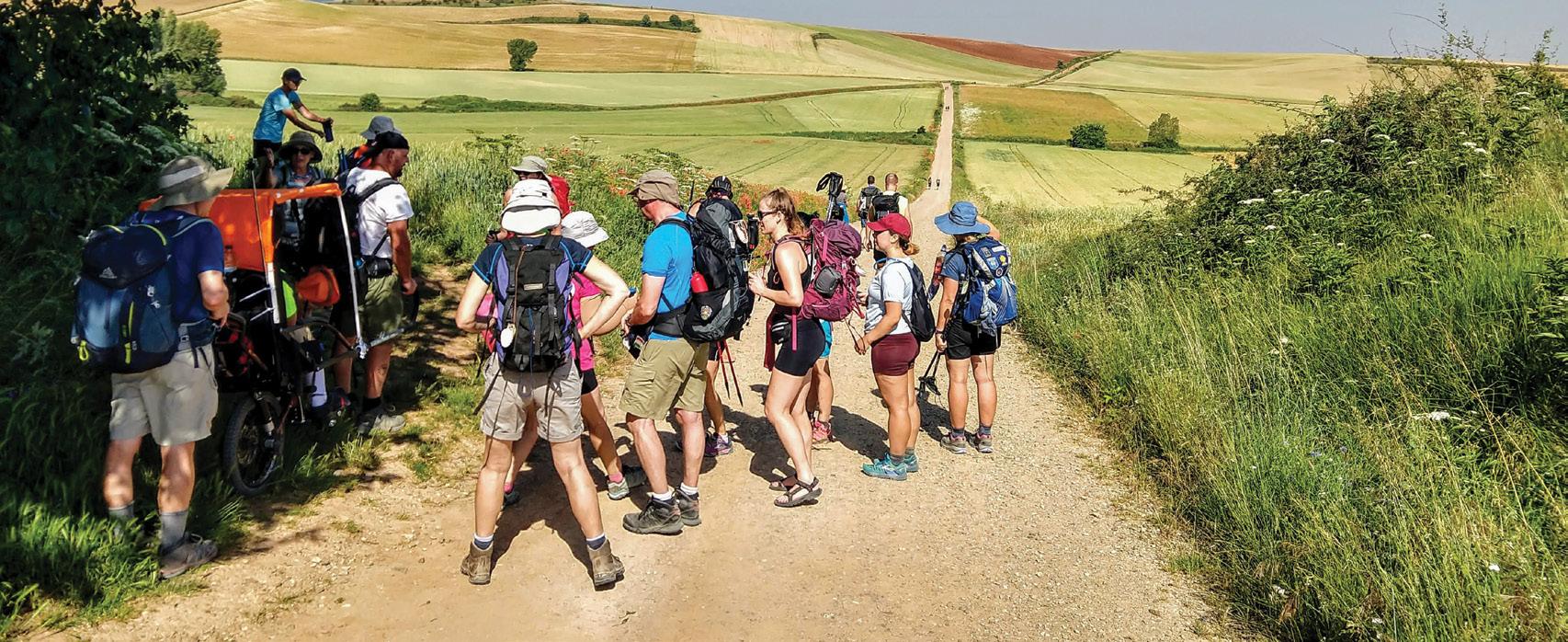
To name just a few members of his band of travelers, there’s Lee, from the UK, who heard about the group while chatting across his bunk at a youth hostel. There’s Rasmus, from Den mark, and Robin, from Ireland, who both joined because they knew Lee. Then Benjamin, from Germany, got recruited to help push Gabriel up a large hill in the Pyrenees and stayed on with the group. Kara, from New York, jumped in to help push, then also continued with the team. And no one is sure when Devon, from Texas, joined, but he became integral in the final kilometers. Reflecting on all of the people who joined along the way, Gabriel says, “This is a dream come true, and the best part is that I got to share the trip and make memories with people who are now friends for life.”
God Orders Every Step
There are various routes pilgrims can take, but they all end at Santiago de Compostela’s cathedral, a soaring Romanesque structure in the heart of the historic part of the city. All year long pilgrims finish their journey on their own time, most without much fanfare. However, on July 11 of this year, as Gabriel and his band walked the final paces on the ancient cobblestone streets of Santiago, they were greeted with an ex
perience they did not anticipate. A friend of Gabriel’s (another Camino connection) flew in to surprise him and walk the final section with him. A documentary crew that was following their journey had put the word out, and there were people at each corner cheering them on. Another friend hung a banner from their balcony. With the end of their weary journey in sight, all this encouragement proved a welcome boost to keep them strong to the finish.
From the start of the trip, they hadn’t planned exactly when they would finish, but coming into the city they realized that the day was July 11, the anniversary of the death of Gabriel’s father nine years ago. Gabriel recalls, “As we passed through the archway into the courtyard of the cathedral, I noticed the Celtic symbols, and thought of my father’s Scottish ancestry. Then out of nowhere, I heard bagpipes playing, which were always at family reunions from his side of our family.” It was as if his father was joining the others who were there to cheer him on. For Gabriel, it was a powerful reminder that God has ordered his every step.
Continuing into the cathedral courtyard for the finish, Gabriel put aside his trekking chair and walked on his own feet for the final steps. As they made their way forward, the bells started ringing and a crowd of people came out of the church after mass. As the team jostled their way through the crowd, the waves of people parted like the Red Sea to make a path to the finish. People on all sides cheered Gabriel on as he and his
24 KNOWN and LOVED | Trinity School
Gabriel Tempest '21 and his team pause with other travelers on the Camino for a rest during their journey.
(right) Some parts of the rugged journey required special support from Gabriel's teammates.

(below) Assisted by Kym and Susan Gardner, Gabriel makes the final steps of the journey on his own two feet as the gathered crowd cheers him on. Photo by Timothy Ringering.
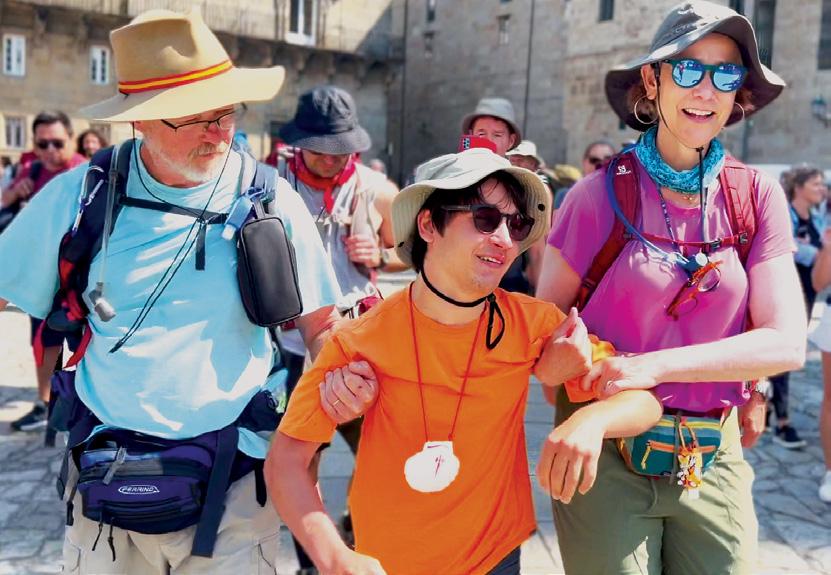

companions walked the final steps of a journey that had taken five years to complete. “I was overwhelmed,” recalled Gabriel. “It was just so emotional to be at the finish, and so much to take in. I’m still processing it to this day.” Gardner says, “It’s an experience I’ll never forget, a truly epic finish and such a special way to end the journey.”
The Journey Continues
While the trek of 500 miles is over, Gabriel’s journey to try new and daring things is not. On this last trip, he met Kara, a serial marathon runner from New York, who invited him to run with her in a marathon in California next spring. “I didn’t think she was serious at first,” admitted Gabriel, but he was convinced when she flew down to North Carolina to do a test run with his recumbent bike. He’s now training to ride in the marathon while Kara takes turns pushing as well. As Gabriel says, “With a group of people, anything is possible. I hope my story can inspire others to make their own wild ideas a reality!”
Read more about Gabriel's journey in the December/January issue of Durham Magazine (https://durhammag.com).

25
With a group of people, anything is possible. I hope my story can inspire others to make their own wild ideas a reality!
Faculty Fast 5
Kelly Oakes

Upper School Visual Arts Teacher
Rudo Mielke

Third Grade Teacher Assistant

Joy Campbell Director of Trinity Neighborhood and Camp Programs
Nate Scott Middle School Math Teacher
The faculty and staff make Trinity School the special place that it is. Get to know some of the figures who bring our mission to life each and every day.
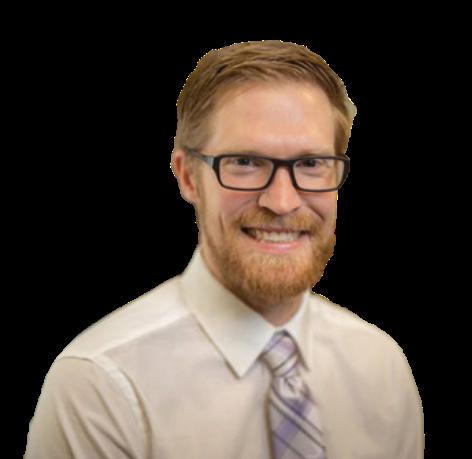
26
KNOWN and LOVED | Trinity School
Where did you grow up? Where are you from?
I grew up in Towson, MD, north of Baltimore, and lived there most of my life. I went to an all-girls Catholic school, where I was taught by nuns and wore a uniform, including a name tag, every day, all year. If I didn’t, I’d receive a detention! I’ve never understood that, since the same nuns knew me each year. In Towson, everyone asks, “Where did you go to school?” (meaning your high school). It is a big town where everyone is connected to their school in some way.
I am from Southern Africa, specifically Zimbabwe.
I was born in the small town of Rutherfordton, NC, but I grew up in Raleigh.
JOY
I was born and raised in Durham, NC.
What’s your favorite Trinity tradition?
Opening Chapel. It is such an exciting time for me to see everyone back at school. The students seem suddenly all grown up! My favorite thing to see is the seniors hand-in-hand with the kindergartners, walking into their last/first Opening Chapel. This always brings back memories of those seniors as younger students, and the realization that these kindergartners will grow up sooner than we think!
I love Lower School Fellowship time. It’s such a gift to be able to intentionally and publicly worship together. Especially coming from a charter school, where we were not allowed to express our faith and opinions, it has been a blessing to not only worship together but also have time set apart for it.
JOY
My favorite Trinity tradition is the Turkey Bowl that the Middle School students compete in prior to Thanksgiving Break.
I like that during the Turkey Bowl I am no longer the students’ teacher, but their coach, so we get to see a different side of each other.
I enjoyed the prayer walk during the faculty and staff in-service before the school year started. I also loved waking Leo the Lion during Opening Chapel!
27
KELLY
KELLY
RUDO
RUDO NATE
NATE
27
RUDO
What do you enjoy the most about teaching or working at Trinity?
I love Trinity students, and how truly kind they are to each other. I notice this especially during lunch period. They are playing games: ping-pong, ball sports, even volleyball, all grades and genders playing together. It always makes me smile.
experience. I learn so much from watching her, and we have some good laughs together. Working here is life-giving, and not everyone can say that about work.
KELLY
My experience of working in schools has been different in the past. Seeing all the pressure students feel to achieve in academics is maddening, and it takes away from the joy of learning. I have enjoyed the different environment here. Our students are just so open and generous about sharing their lives with us, and that is such a gift. There are three girls who often bring over different “food platters” made from pine cones, leaves, or whatever they have foraged in the woods...and I just love that. I have also enjoyed working with my lead teacher, which has been a sweet
My favorite thing about teaching at Trinity is that Dr. Hall gives me freedom in how I teach algebra. I am encouraged to be creative and make the curriculum fun and engaging for students.
JOY I love that we are a community of praying people. I haven’t been here very long, and there was a particular day soon after I started when someone saw that I needed a hug and prayer. She could see it on my face. She immediately hugged me so tightly that I could actually feel the love, and she prayed for me right away. At that moment, I knew I belonged at Trinity!
Why did you choose a career in education?
It started when my middle son, who has autism, needed assistance sometimes in school. I worked as a classroom assistant in another class, just in case. After a while, I wasn’t needed anymore, but I loved being in the classroom, especially a Christian one, where we could openly talk about faith in God. About 15 years ago, I was

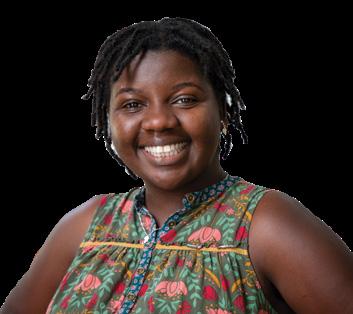

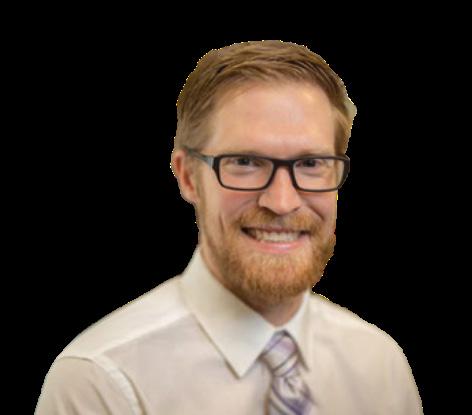
lucky enough to be able to teach about art, how God gives us talents and passions, and how to use them for the greater good.
I love working with children. I volunteered at a school for a few months once, and that was it...I was sold.
28
KELLY
RUDO
NATE
Why did you choose a career in education?
I chose education for a career because I love interacting with children. When I was in high school and college I worked at a variety of summer camps and afterschool programs. I believe that as a teacher I am changing lives and helping shape the next generation of young people that will lead our community.
I have had a love for children since high school and always wanted to continue working with families when I got older.
What’s something we might not know about you?
The day after I married my husband, Jack, we moved to Tokyo, Japan for a while. He was in business school and also studied Japanese, so we were there for his last year of school. I did not speak Japanese, but I taught English. I was also was an “extra” in Japanese commercials and soap operas!
I am bilingual, so my dreams are bilingual as well, and sometimes my dreams are animated (as in cartoons).
You may not know that I went on a 10day mission trip to Muniguda, India, in 2015. I was part of a team that delivered medical supplies to the Bethel Ministry in a very rural village. The ministry also served as an orphanage for 78 young boys and girls. Many Christians in India are persecuted for their faith, and it was a blessing that God could use me to lift up my brothers and sisters in Christ who live halfway around the world.
In 2007, I tried out for American Idol in Atlanta (the year Jordin Sparks won). I was very nervous the entire drive down there on I-85. I sang in front of four judges, singing the only song I had prepared. This was the first audition that you had to get through in order to get to the final auditions held on television. The judges liked me and wanted to hear another song. So, I scrambled in my head for another good song (that I knew all the words to). When your adrenaline is rushing, it’s so hard to think straight. When I was called back up to sing, the second song wasn’t quite as impressive as the first. They did not choose me to advance, but the experience was so worth it, and one that I can grow old to tell my grandchildren about.
Did you know?
Out of 140 faculty and staff, there are seven married couples who work at Trinity together.
29
KELLY
RUDO
NATE NATE
JOY JOY
A Faithful Neighbor
by DAVID NOLEN
If you drive up the gravel portion of Pickett Road or venture to join the Trinity Cross-Country team for an afternoon run, you will probably spot a black mailbox at the foot of a driveway adjacent to campus that leads to a pleasant home surrounded by beautiful hay fields frequented by deer. This is the Penny property. Carolyn and Wade Penny, Trinity’s next-door neighbors ever since the building of Trinity’s campus, were married for 65 years until Mr. Penny passed away last November. Mr. Penny left a mark on the community around him, and his character is admirable. I talked with Mrs. Penny at her home, who shared with me a little about her late husband.
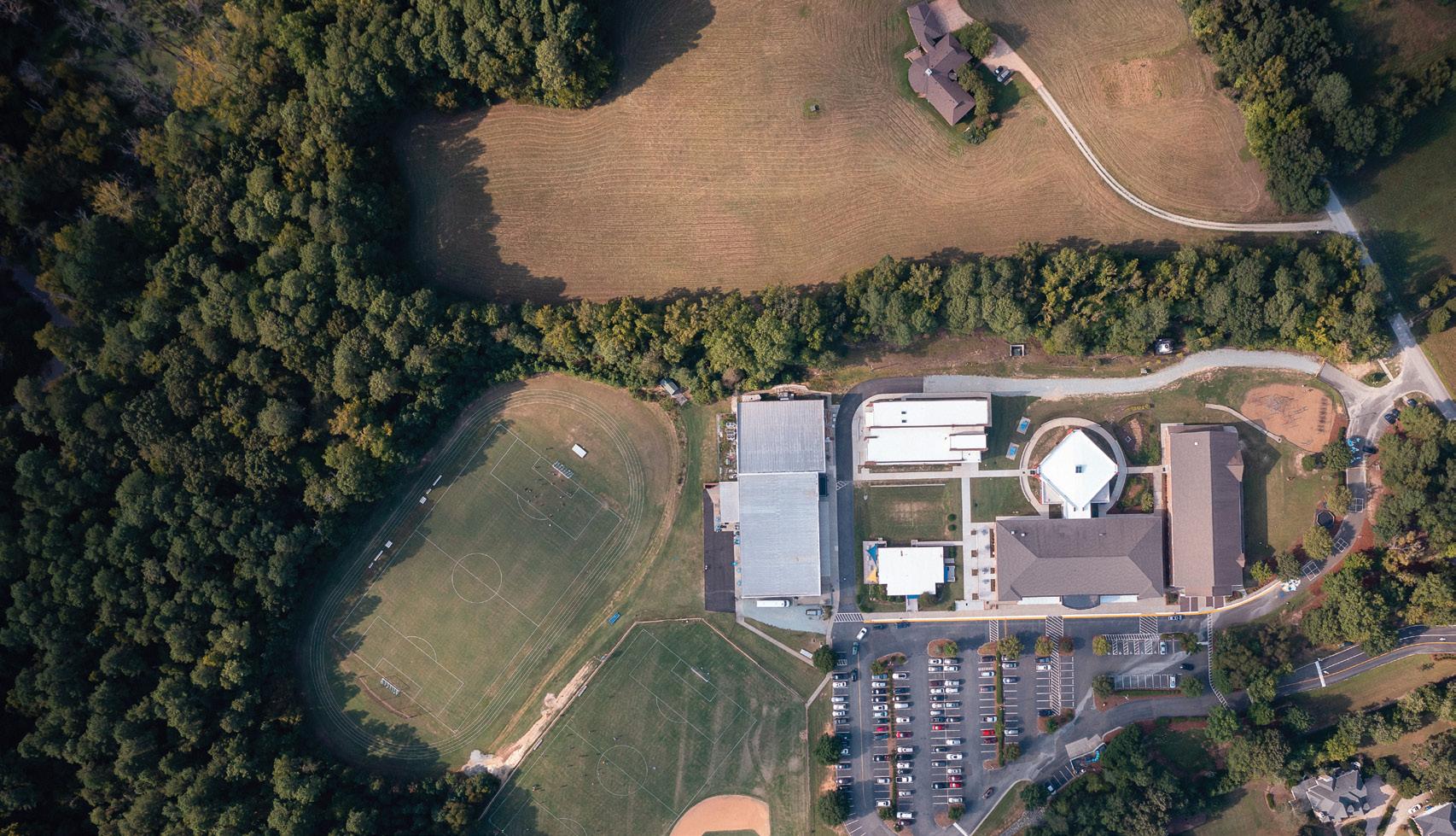
Mr. Penny’s caring and kind character was evident in his interactions with the people in his local community. Mrs. Penny told me how her husband, a lawyer, showed active benevolence in his work. In 1963, Mr. Penny stepped in to argue for a civil rights case that emerged from a local Durham event. This sensitive case was brought to the North Carolina Supreme Court, and at 30 years old Mr. Penny argued and won. However, this was not just a spon taneous moment of kindness to others: Mrs. Penny noted
that for his whole life, “he was dedicated to serving all the citizens,” whether in court or among his local neighbors.
I spoke about this with Jeff Fisher, a Trinity parent and neighbor of Mrs. Penny’s, who told me about his interac tions with Mr. Penny over the years. Mr. Fisher de scribed the many lessons he had learned from Mr. Penny, who was a kind and caring friend—especially the lesson that all of us ought to love and care for our neighbors, which “is an extension of Christ’s teachings.” He pointed out Mark chapter 12, in which Jesus teaches that loving our neighbors is the greatest rule by which we can live.
Mr. Penny’s character shone throughout his life through his love for his neighbors, but it also shaped his passion for nature. His love for people was reflected in the ways that he loved God’s other creatures. Mrs. Penny de scribed how Mr. Penny would frequently stop to give aid to box turtles crossing the road nearby. This simple act of unrewarded kindness captures his character brilliantly. Mr. Penny was always on the lookout for opportunities to be kind to others, whether interacting with his human neighbors or the neighboring animals around him.
30
KNOWN and LOVED | Trinity School
July 2006 – Wade and Carolyn Penny stand on the Hollow Rock outcrop on property along New Hope Creek that they sold to a land conservation interest. Their land and others help make up the more than 100 acres of preserve along Erwin Road now known as Hollow Rock Nature Park.


Mr. Penny was deeply passionate about the environment and wished to protect the beautiful forests and rolling hills of North Carolina. If you have ever seen the Penny property, you will have noticed how tidy and beautiful the Penny hay fields have been kept over the years. Mr. Fisher described how Mr. Penny “would tend the fields around his house with loving care, pulling invasive thistles.” Penny’s care and devotion to nature was shown in small ways and also in big ways, such as his work on a conservation easement for the acres of woods nearby Trinity. This conservation effort, now called Hollow Rock Nature Preserve, was arranged by the Pennys and others, including Mr. Fisher, who is an attorney. Mrs. Penny shared, “Wade and I agreed that the land needs to be preserved and made accessible for everyone to enjoy.”
Indeed, many of us have enjoyed running or walking in the Hollow Rock woods. If you haven’t yet discovered these woods, be sure to go on a hike there and enjoy the local North Carolina wildlife that has been conserved thanks to the efforts of Mr. Penny and others.

Mr. Penny lived in a Christ-like way, and his character was one we should strive to emulate. This year’s school verse, 1 John 3:18, challenges us to love through our actions and character—in other words, by being good neighbors. Mr. Penny embodied this idea of neighborly character, living out a life of kindness and care for others through his actions. From the life of Mr. Penny we can learn how to love both who and what is around us.
DAVID NOLEN is in his 11th year at Trinity. He enjoys Trinity visual arts, running cross-country and track, serving on the Honor Council, and coding for the Robotics team. Outside of school, David loves fly fishing and spin casting in local waters and runs his own lawn and yard business in his neighborhood.
31
LEARNING
athletics

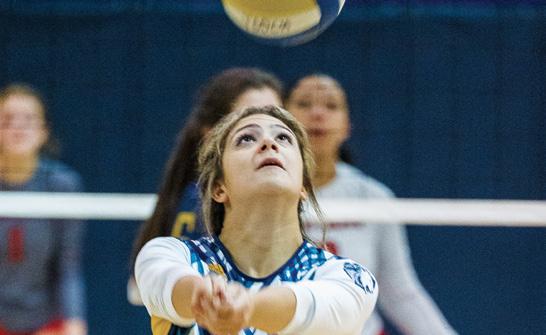
 By Abigail Jacob
By Abigail Jacob
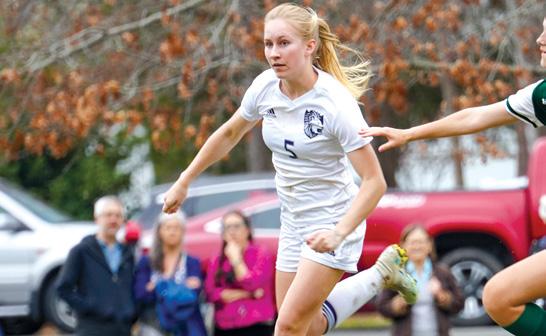
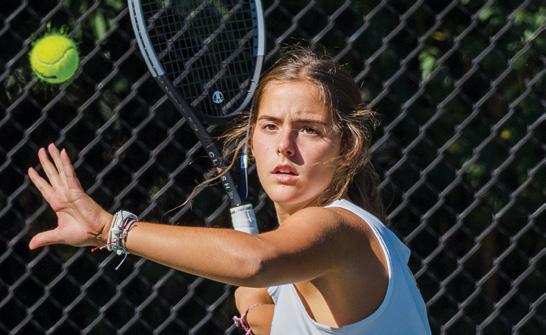
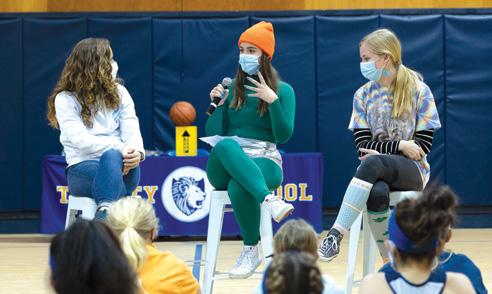
The Student-Athlete Leadership Team was born out of a Senior Capstone Project. Abby Love ’21 helped shape the group—its makeup, purpose, and vision. She researched models at other schools and helped to define who should be nominated and how they should serve. Now in its second year, the group is growing in confidence, advocacy, and influence for good.

NON NOBIS | Trinity School
s a l t IN
Photos by Evan Pike
Trinity’s Student-Athlete Leadership Team (SALT) is a committee of students who demonstrate strong leadership in their sports and eagerness to improve Trin ity athletics. We have all committed to lead by example, both on and off the field, track, and court. While playing, we bring energy and competitiveness to our team, while emphasizing the importance of winning and also losing with grace. Being made in the image of God, we want to reflect and honor his goodness and grace throughout our play. Off the field, we look for opportunities to serve and support the Trinity community, and we discuss ways to do this in our weekly SALT meetings. Also, to show our appreciation to coaches and staff, we often volunteer to help out, sweeping floors after basketball games or staying longer after games to put away equipment. Through our actions, we hope to inspire other athletes to serve in similar ways.
To support our fellow student-athletes, we organize fun and enjoyable events like sports festivals, speaker lunch es, team dinners, and interviews. We helped organize Trinity’s first Student Athlete Retreat, where we heard from Dr. Greg Dale, a sports psychologist. The SALT team served the other athletes as leaders and facilita tors as we talked about what motivates us extrinsically
and intrinsically related to our individual sports, how to relate to coaches, and what we hope to leave as a legacy at the season's end.
During a speaker lunch last spring, Mr. Mike Echsten kamper, the director of Athletes in Action at UNC-CH, came to talk with the athletes. The SALT team came up with questions and facilitated the discussion. Being a student-athlete can be stressful, so we asked Mr. Ech stenkamper to help us understand how to balance our ac tivities and stay motivated. He gave us great insights into all the ways school and sports benefit from each other, like stress relief and building mental toughness. He also taught us how to stay motivated and humble. After Mr. Echstenkamper’s talk, many athletes who had lost their spirit and competitiveness felt equipped to start fresh and grew excited again.
Besides teaching new techniques and important lessons, events like these build relationships within the Athlet ics Department and help us support and encourage one another more deeply and more often. I love being on the SALT team, because it gives me this opportunity to build community. I get the chance to grow as an individual, while simultaneously helping others around me.
“I’m delighted to help facilitate this group in their endeavors. They are a diverse group of athletes with fascinating perspectives and passion for change in athletics and school culture. They are keenly aware of this opportunity to contribute as servant leaders, and it’s a joy to see their growth and desire for holistic excellence in athletics from the ground up and to reach every corner of campus!”
– SOPHIE SMITH , Athletic Director
ABIGAIL JACOB has been a Trinity student for eight years. She loves community and being busy. To fill her time she leads art clubs, participates in three sports a year, and for her senior year has taken on the role of Student Life co-chair. She loves talking and enjoys having conversations with all types of people.

33
Why We Give
The Anne K. Stouffer Endowed Scholarship

The Anne K. Stouffer Endowed Scholarship is named in memory of my mother, a devout Christian woman and native of Asheville. By funding this scholarship my family and I hope to perpetuate her memory and honor all of the good that she did during her life. She believed very much in Jesus as her personal Savior, and in supporting organizations that would help others build their faith. My mother worked with several nonprofits that helped spread the gospel, and we felt that Trinity’s mission
By Rick Stouffer endowed scholarship
to educate students in the framework of Christian faith aligned with her personal mission to share the gospel with others. Our daughter, Jeanie, attended Trinity for three years while in high school, and the experience provided her a comprehensive education and helped build her faith. After graduating, she attended James Madison University and then earned graduate degrees from James Madison and the University of Virginia. She is now working for the School of Education at Virginia Commonwealth University as
a Project Coordinator. Jeanie’s interest in education and teaching was sparked at Trinity, and her time there gave her the foundation to be successful in college. Our experience with Trinity led Meg and I to fund a scholarship that would support students and families who don’t have the resources to attend Trinity. We are grateful to be able to support Trinity and to help deserving students by reducing financial barriers.
34 NON NOBIS | Trinity School
The Anne K. Stouffer Endowed Scholarship provides the annual financial assistance needed to make a Trinity education possible for one of our students.
Investing in Trinity’s Mission
THE MISSION OF TRINITY SCHOOL
To educate students in transitional kindergarten to grade twelve within the framework of Christian faith and conviction—teaching the classical tools of learning; providing a rich yet unhurried education; and communicating truth, goodness, and beauty.
Every gift, no matter the size, is a commitment to help our students grow rich in understanding, close in relationships, and always curious to learn more, all in the spirit of Non Nobis.
Consider investing in Trinity’s Christian, classical, rich and unhurried mission with a gift to the Trinity Fund. If you’d like to discuss supporting an existing endowment, please reach out to our Advancement Office (advancement@tsdch.org).
Trinity School of Durham and Chapel Hill Advancement Office 4011 Pickett Road, Durham, NC 27705


Gifts to Trinity support every
student’s experience.
at
aspect of a
Give
trinitygives.org
MAIL A CHECK GIVE ONLINE
Alumni News & Notes
Alumni News & Notes
 Middle School Graduates
Middle School Graduates
In June 2022, Satie Munn ’03MS transitioned employment and joined Parsons Corporation, a technology-focused defense, intelligence, security, and infrastructure engineering firm, as corporate counsel. Satie and her beagle-mix "Judge" love living in the Plaza Midwood neighborhood in Charlotte.
Stuart Howes ’08MS debuted his feature film Tableau, which premiered at the Charlotte Film Festival in October. The film was selected as the opening night film at the 2022 Carrboro Film Fest. You can follow Tableau on Instagram @TableauMovie or at TableauMovie.com.
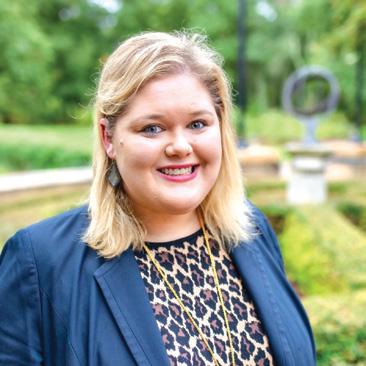
36 NON NOBIS | Trinity School
Class of 2011
Lauren Hubbard Shelton ’11 graduated from Mayo Clinic’s Orthopedic Physical Therapy Residency last fall and has since moved back to Durham with her husband Shane and daughter Sawyer. She is now working on a project called Stability Flow, which is an online platform that helps yoga practitioners develop strength and prevent injury. Her favorite thing about moving back to Durham is being able to have so many friends nearby, including alumna MaryMac (Thielman) Hoehn ‘05MS, whose daughter Kit is now good friends with Sawyer. Lauren and MaryMac can’t wait to have second-generation Trinity Lions!
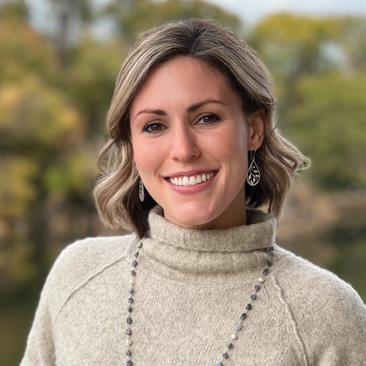
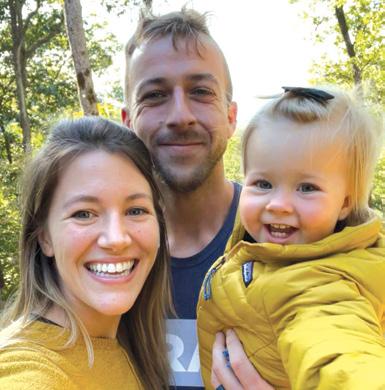
The Durham Police Department promoted Jack Wagstaff '11 to sergeant in August. He now leads a uniform patrol squad in north Durham.

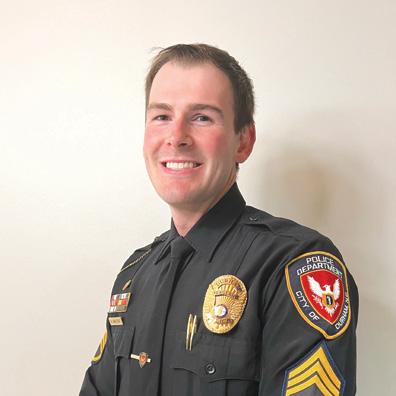
Arwen (La Dine) Broughton ’13 and her husband James welcomed their first child, John Broughton, on July 22, 2022.

Sarah Hand ’11 married Jeremiah Safford on July 10 of this year. They are both so thankful to God for bringing them together!
Class of 2013
Zoe Whisenhunt ’13 transitioned from her service as captain in the US Army into the corporate world. Since November 2021 she has worked as a recruiter for the executive search firm Heidrick and Struggles. She recently moved to midtown Atlanta, where her company has corporate offices. Zoe has enjoyed getting to know the city, taking up aerial silks and kickboxing as hobbies! She is also working on her master’s degree in national security from the American Military University.
37
Class of 2013
Class of 2014
Tyler Eckstein ’13 has been promoted to Director of Basketball Operations for the Furman University Men's Basketball team after working for the last seven seasons as the team's Video and Analytics Coordinator and Head Student Manager. "Tyler has earned this opportunity to be promoted, and I look forward to continuing to watch his growth," said Furman Head Basketball Coach Bob Richey. "His ability to love, serve, and care is uncommon, and this impacts our players and our entire program on a daily basis…We aren't the program we are today without Tyler Eckstein being a part of it, and everybody associated with our program would agree."
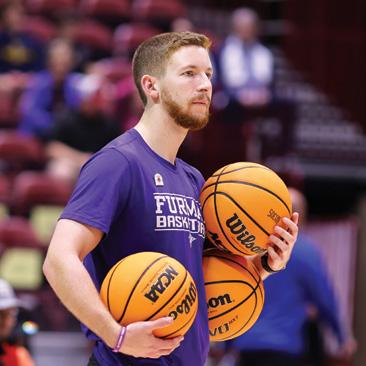
Alaina (Yeatts) Weaver ‘14 and her husband Blake welcomed twins Beckett and Winnie in June 2022.


Olivia Chaney ’14 graduated from Dallas Theological Seminary in May 2022 with a master’s degree in media arts. She hosts The Games Podcast, which covers the history of the modern Olympic Games. Search for it wherever you listen to podcasts.
Class of 2015
Victoria James ’15 has spent the past three years in Connecticut, graduating from UConn Law School in May. While in law school, she coached middle school basketball and soccer at a school very similar to Trinity. She now works as a civil defense litigation attorney in downtown Hartford. She is enjoying living in New England—explor ing towns and nature!
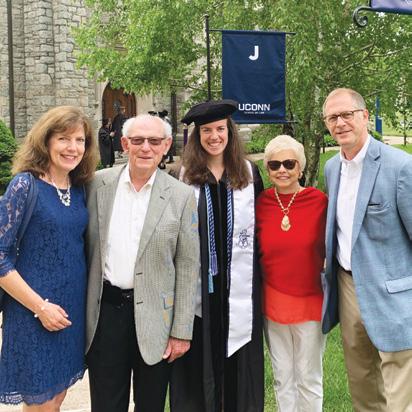

Class of 2017
Josh Bryan ’17 and Jenna Bryan were married in Braemar, Scotland, on August 4, 2022. The wedding was a memorable day for the little group of 12 family members in attendance. Josh and Jenna live in Charlotte, where they attend Life Church, and Josh just started a new job with Truist Bank.
38
Class of 2018
Class of 2019
Luke Garges ’18 graduated from Furman Univer sity in May 2022 with a bachelor of science in biology on the biomedical track. He enjoyed his time in college, spending long hours with his friends at RUF and playing club tennis, as well as any other intramural sport he could! He is now in his first year of veterinary school at Virginia Tech in Blacks burg, VA, where he is staying busy learning as much as he can about veterinary medicine.

Class of 2019
Hope Mutter ’19 was awarded the John and June Allcott Travel Fellowship from the UNC–CH Art Department for the summer of 2022. She traveled to Bogotá, Columbia, and did research on the art found in churches, basilicas, and cathedrals in and around the city, which were designed by the Spanish but built by the native Muiscas. The influence of their own native religion is present in the art and architecture that they had a hand in constructing. Hope lived in Bogotá for two months and will present her work at the Spring Honors Symposium at UNC–CH. She also has been selected as the art editor of UNC’s literary magazine, The Cellar Door, for the 2022–2023 school year.
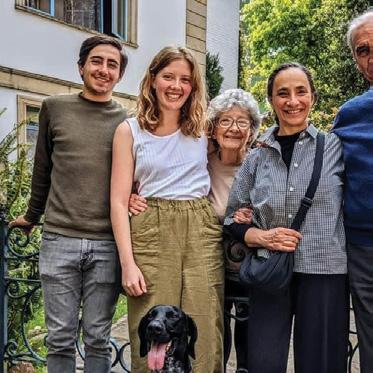
This past summer, Annabel Smith ’19 moved to Washington, DC, to work at the Center for Public Justice as a Communications Associate Intern. During her time there, she worked on enhancing their social media presence through informative graphics and designed the entire layout for this year’s Hatfield Prize Public Policy report.
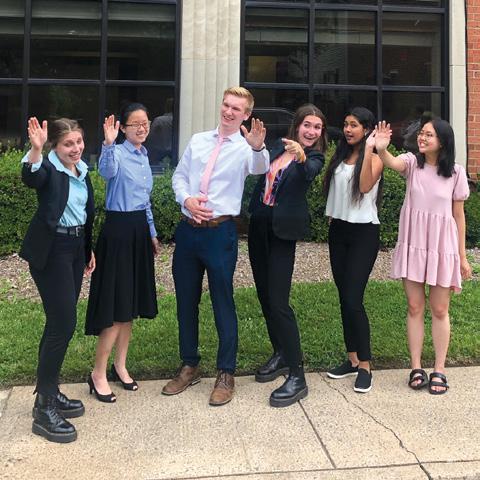
Class of 2020
As a junior at High Point University, Karley Long ’20 serves as a student ambassador, leading tours for interested families and working in the admissions office. Recently, she was ap pointed team leader for a new live/virtual tour option. In January 2023, Karley will embark on the Semester at Sea study abroad program. She’ll leave from Dubai and travel with 600 other students on a cruise ship to twelve different ports across the globe. During the semester she will immerse herself in several psychology courses and a Global Studies class.

39
Class of 2020
Ansley Anders ’20 is currently a junior at UNC majoring in political science and history and is also a PPE (politics, philos ophy, and economics) minor. This past summer she studied abroad in Florence, Italy, at the Istituto Lorenzo de’ Medici, taking courses in history and Italian. She is applying to study abroad again this com ing spring at the University of St. Andrews in Scotland, where she hopes to learn under their renowned history faculty. On campus at UNC, she is a study abroad ambassador and promotes study abroad programs. She is also a member of the Phi Alpha Delta pre-law fraternity and is involved in WINS (Women in National Securi ty), as well as in College Collective, the Chapel Hill Bible Church's college ministry.


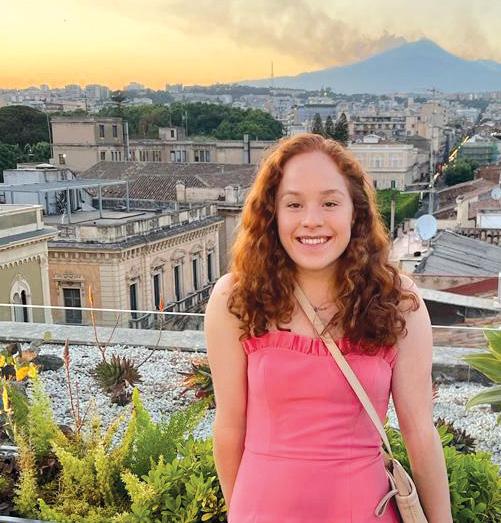
Class of 2021
Lauren Garges ’20 is a junior at Furman University, majoring in health sciences. She traveled to Portugal last summer to learn about the Portuguese healthcare system and completed a summer surgical internship at Prisma Health in Greenville, SC, where she conducted clinical research and observed all types of surgeries. She is enjoying her college years, playing club volleyball, and is active in her sorority, where she is on the Leadership Council. This semester she is studying abroad in Copenhagen, where she continues to learn about global healthcare systems. She plans to attend medical school after she graduates.
Elise Benware ’21 served as an intern for North Carolina Representative Pricey Harrison this past summer. As an intern, she learned firsthand about the type of work our state representatives conduct in the NC House, especially about environmentally related legislation. Elise is currently in her sophomore year at UNC–Chapel Hill, where she is an environmental studies and political science double major with a minor in environmental justice.
Franklin Kennedy ’21 studied abroad in Ireland this summer for six weeks with the UNC Science in Dublin program, where he took cours es in organic chemistry and Celtic myth and legend.
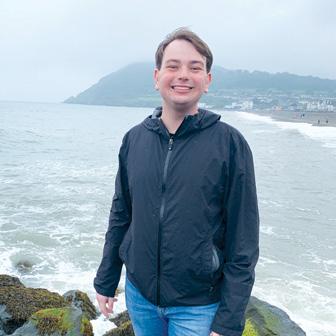
40
This year brought the return of the Harvest Hoedown, a long-standing Trinity kindergarten tradition. This special event offers parents and special guests a chance to experience the fun their students have while learning music. Throughout this semester, music teacher Jessica Holmes has been working with the students to lay down foundational elements of music, including singing, listening, moving, and playing. Music class also gives kindergartners the opportunity to practice collaborating with others as they perform in an ensemble, a skill they will continue to build on in their future musical studies at Trinity. At the Hoedown, guests got in on the fun and joined their students in a partnered dance! The students’ faces beamed with joy as they shared all they had learned, and it was a delight to gather once again as a Trinity community celebrating our students and the joy of learning.
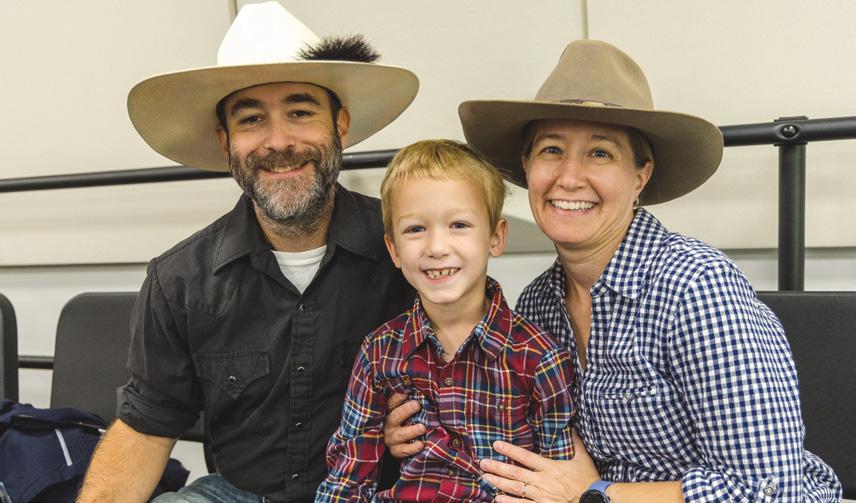
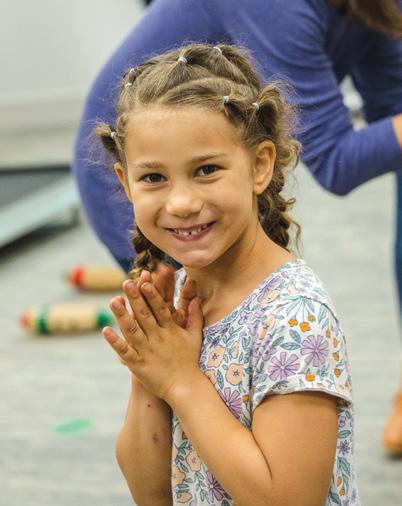
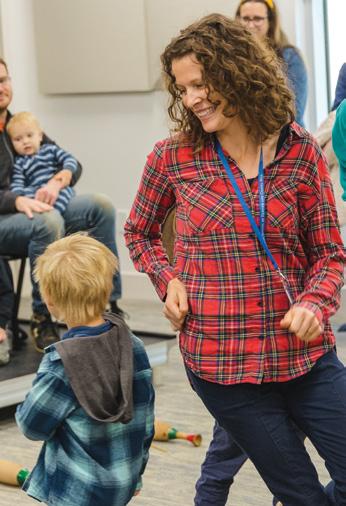
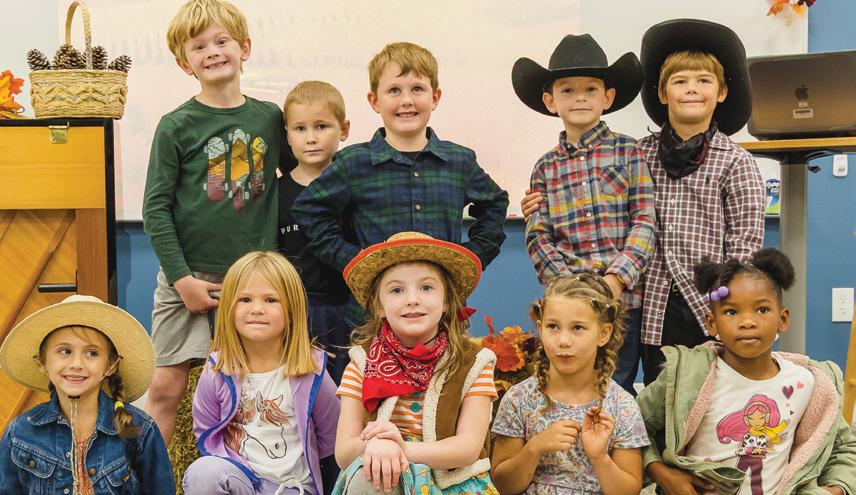

4011 Pickett Road
Durham, NC 27705 trinityschoolnc.org
Celebrating the FALL FESTIVAL




What a joyous celebration we experienced at this year’s Fall Festival! With face-painting and “fairy hair,” a dunk tank, inflatable slides, Q Shack BBQ, and more, there was fun for all. After a two-year break due to the pandemic, families eagerly gathered for a beautiful fall afternoon of making memories together.
 Trinity School of Durham and Chapel Hill
Trinity School of Durham and Chapel Hill






 Chip Denton, Head of School
Chip Denton, Head of School





























 By Rebecca Nolen
By Rebecca Nolen










 By Joan Monnig and a selection of sixth grade students
KNOWN and LOVED | Trinity School
By Joan Monnig and a selection of sixth grade students
KNOWN and LOVED | Trinity School













 by NATHAN CLENDENIN
KNOWN and LOVED | Trinity School
by NATHAN CLENDENIN
KNOWN and LOVED | Trinity School




















 By Abigail Jacob
By Abigail Jacob







 Middle School Graduates
Middle School Graduates




























 Trinity School of Durham and Chapel Hill
Trinity School of Durham and Chapel Hill